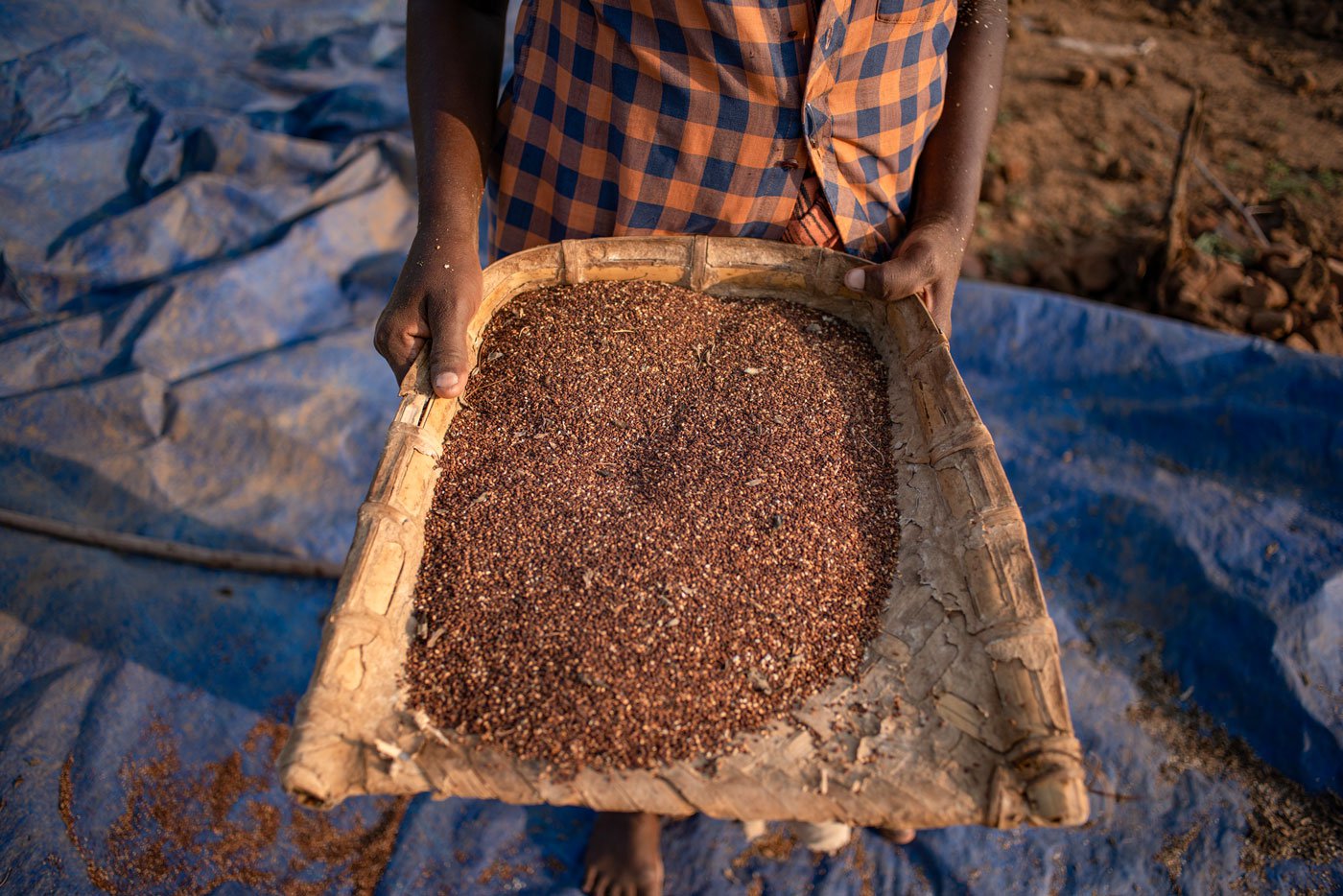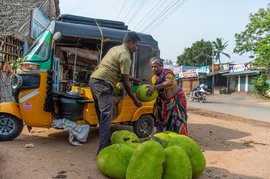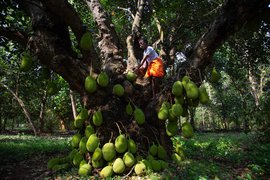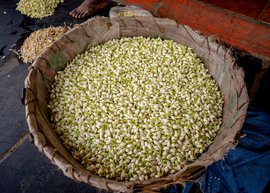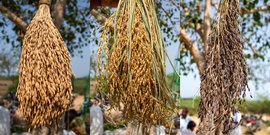In the gathering darkness on the sandy bank of the Kollidam river, 10 minutes from his sesame fields near Srirangam, farmer Vadivelan tells me stories. Of this very river in spate, 12 days after he was born in 1978. Of his village, where everybody grew ellu (sesame seed) that is crushed for its honey-coloured, fragrant oil. Of learning to swim ‘clutching two banana plants that floated on the water,’ falling in love with Priya, who lived on the banks of a bigger river – Cauvery, marrying her despite his father’s objections. And farming their one and a half acres with paddy, sugarcane, black gram and sesame…
The first three crops fetch some money. “We use the income from raising paddy to cultivate sugarcane, and we plough that money back into the land,” Vadivelan explains. Sesame – ellu in Tamil – is raised for oil. The seeds are crushed in a wood press, and the nallenai (sesame or gingelly oil) is stored in a large pot. “We use it for cooking, to make pickles,” Priya says, “oh, and he gargles daily with it.” Vadivelan grins. “And oil-baths,” he says, “I love that!”
There are many things Vadivelan loves, and all of them are simple pleasures. Fishing in this river as a young boy, grilling and eating the fresh catch with his friends; watching the only television in the village, in the panchayat leader’s house. “Why, I liked TV so much, I would even listen to the ‘oiiin’ sound when it didn’t work properly!”
But the rose-tinted nostalgia fades, just like the daylight. “You can no longer depend on the land alone,” Vadivelan points out. “We manage because I also drive a cab.” He’s brought us in his Toyota Etios from his house in Thiruvalarsolai, Srirangam taluk to the river bank. He had bought the car with a private loan at eight per cent interest; the repayment is a hefty Rs. 25,000 a month. Money is always a struggle, the couple says. Often, a piece of gold is pledged to tide over tough times. “Look, if people like us wanted a bank loan to build a house,” Vadivelan sighs, “we will wear down 10 pairs of chappals. That’s how much they will make us run around!”
The sky is now an oil painting: pink and blue and
black. A peacock calls from somewhere. “There are otters in the river,”
Vadivelan says. Not far from us, young boys dive and play as nimble as otters. “That’s what I did too, there was no other
entertainment growing up here!”
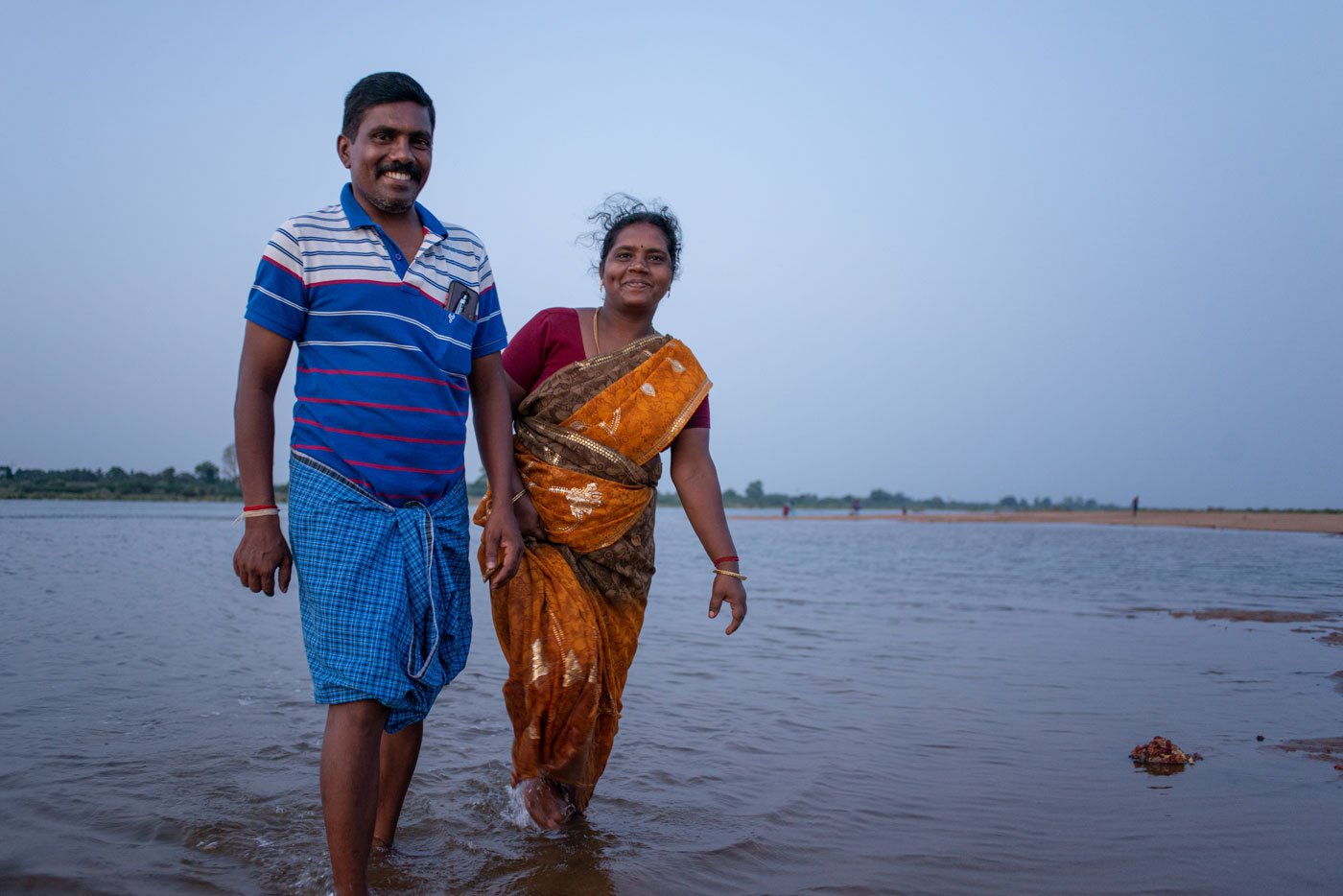
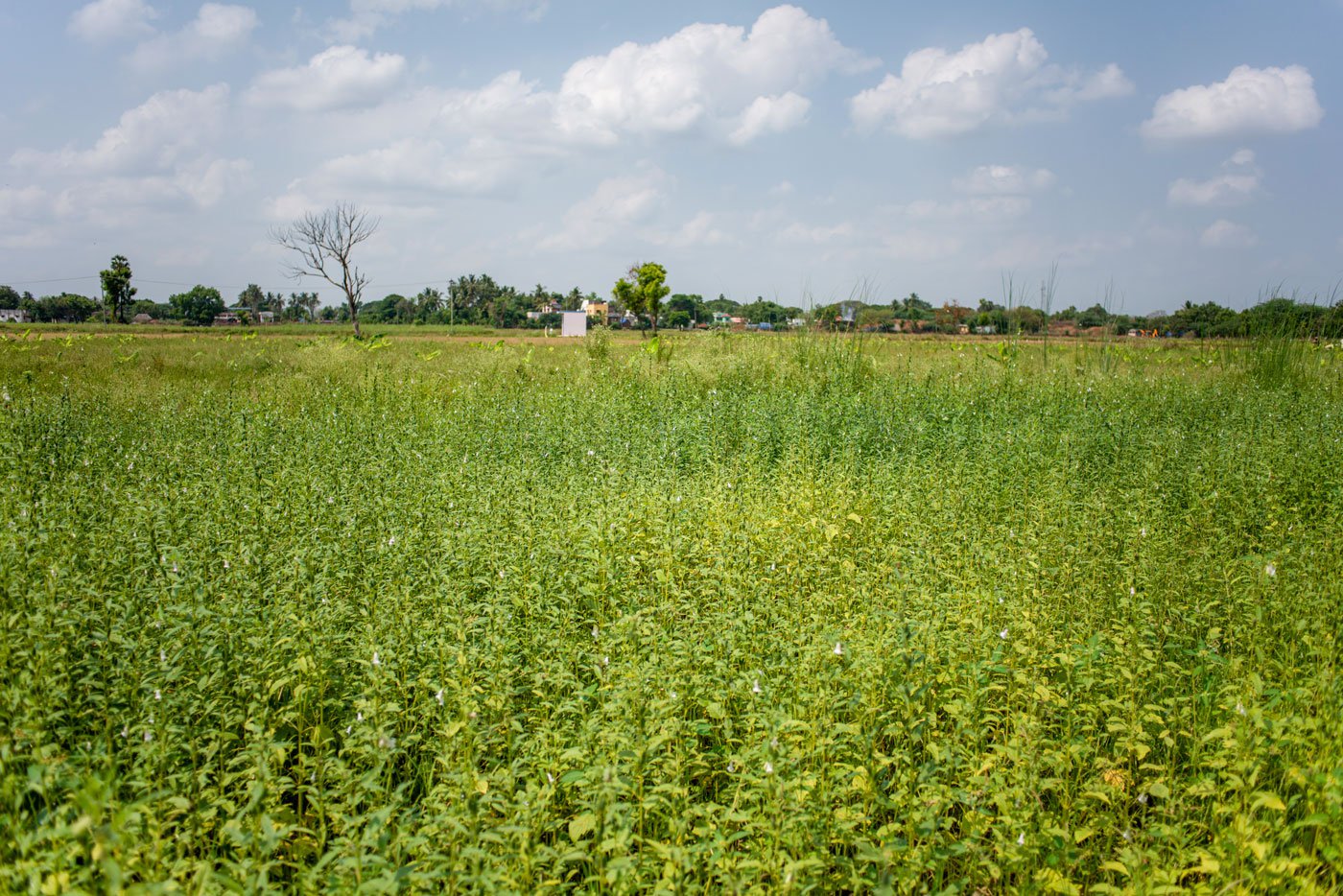
Vadivelan and Priya (left) on the banks of Kollidam river at sunset, 10 minutes from their sesame fields (right) in Tiruchirappalli district of Tamil Nadu
Vadivelan also worships the rivers. “Every year, on Aadi Perukku - the 18th day in the Tamil month of Aadi – all of us go to the banks of Cauvery. We break a coconut, light camphor and offer flowers and prayers.” As if in return, Cauvery and Kollidam (Coleroon) nourish their fields here in Tiruchirappalli (also spelt as Trichy) district of Tamil Nadu, as the rivers have done, for almost 2,000 years.
*****
“Offering steamed lentils, sesame seed balls, rice mixed
with meat,
flowers, incense and freshly cooked
rice
women hold hands together and dance in
a trance
as old elegant women bless and
proclaim
“In this great land led by our ruler
may hunger, disease and enmity leave;
may rains and wealth spring forth”
This prayer ritual, from the Tamil epic Silappathikaaram, written in the 2nd century CE, “is almost the same as it is practiced in Tamil Nadu today,” writes Chenthil Nathan, in his blog Old Tamil Poetry. [Poem: Indira Vizhavu, lines 68-75]
Ellu (sesame) is both ancient and commonplace. And a crop that has various – and interesting – uses. Nallenai , as sesame oil is called, is a popular cooking fat in south India, and the seeds are also used in native and foreign desserts. The little white or black sesame lends a lovely bite to savoury dishes, and it is an important part of rituals, particularly ones where ancestors are remembered or worshipped.
Sesame seeds contain 50 per cent oil, 25 per cent
protein and 15 per cent carbohydrate. An Indian Council for Agricultural
Research (ICAR) project on
sesame
and niger notes that , it is a ‘store house of energy
and very rich in vitamins E, A, B Complex and minerals viz., calcium,
phosphorus, iron, copper, magnesium, zinc and potassium.’ Not surprisingly, the
meal after the oil is pressed –
ellu punaaku
– is fed to livestock.
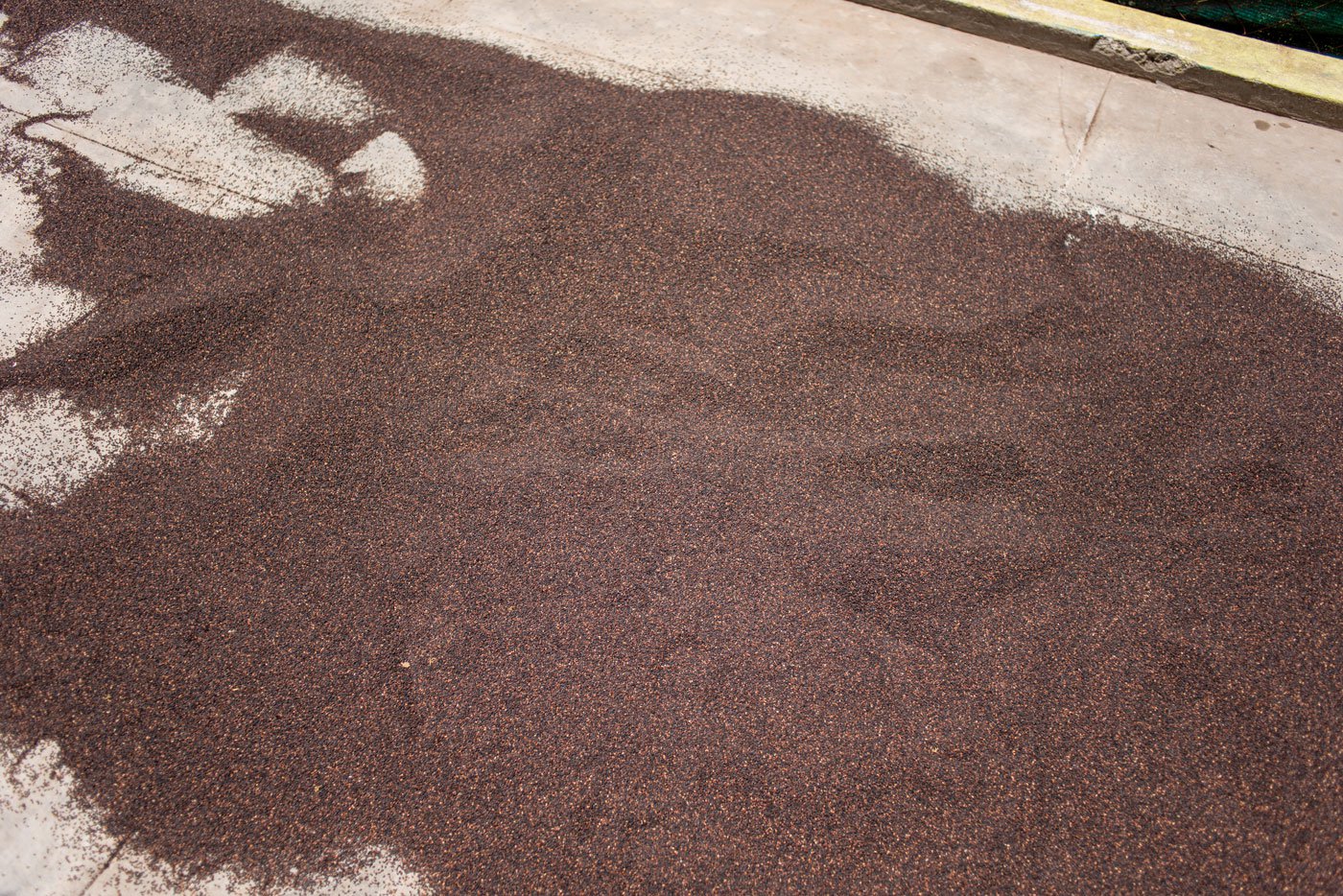
Ellu (sesame) is both ancient and commonplace with various uses – as nallenai (sesame oil), as seeds used in desserts and savoury dishes, and as an important part of rituals. Sesame seeds drying behind the oil press in Srirangam
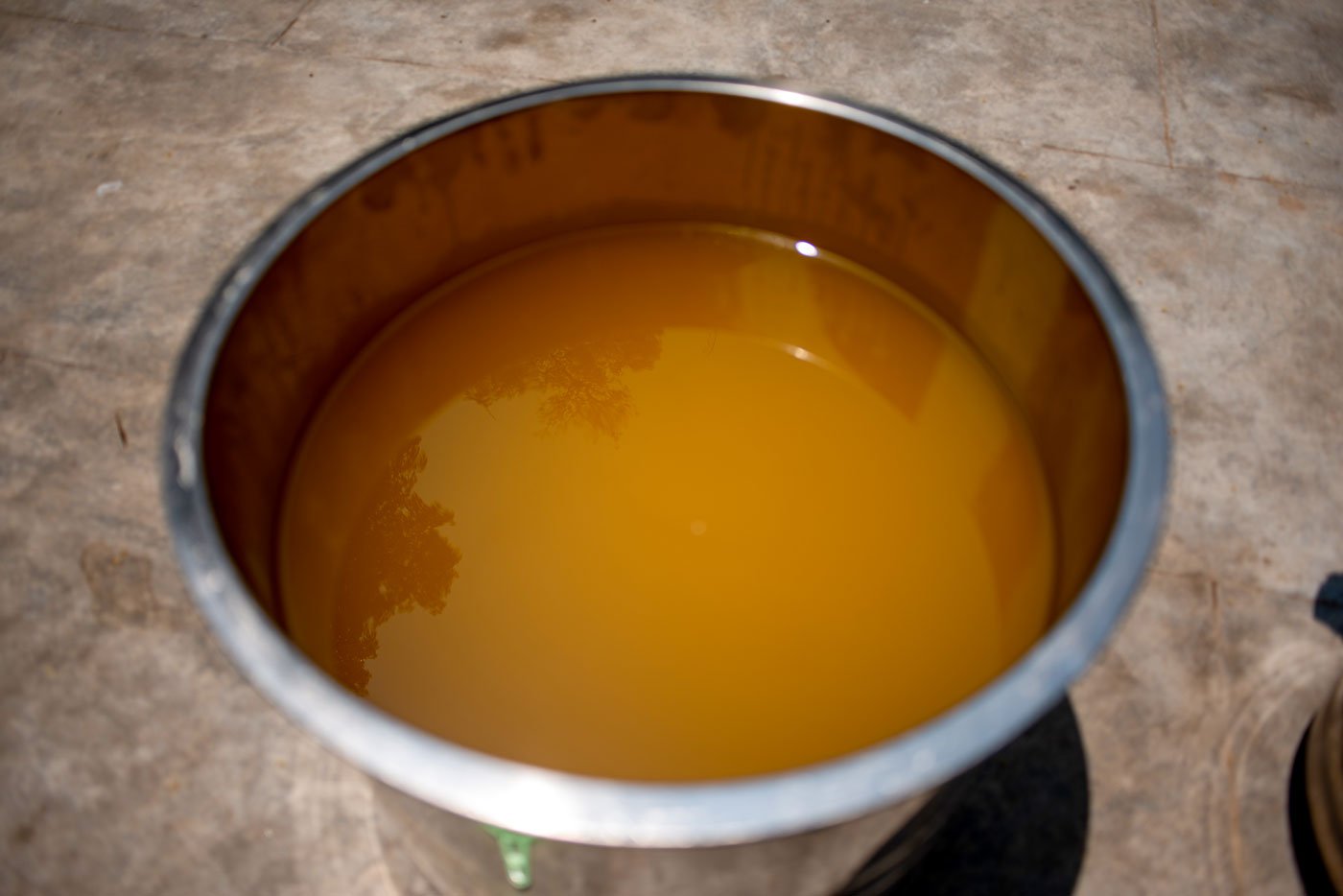
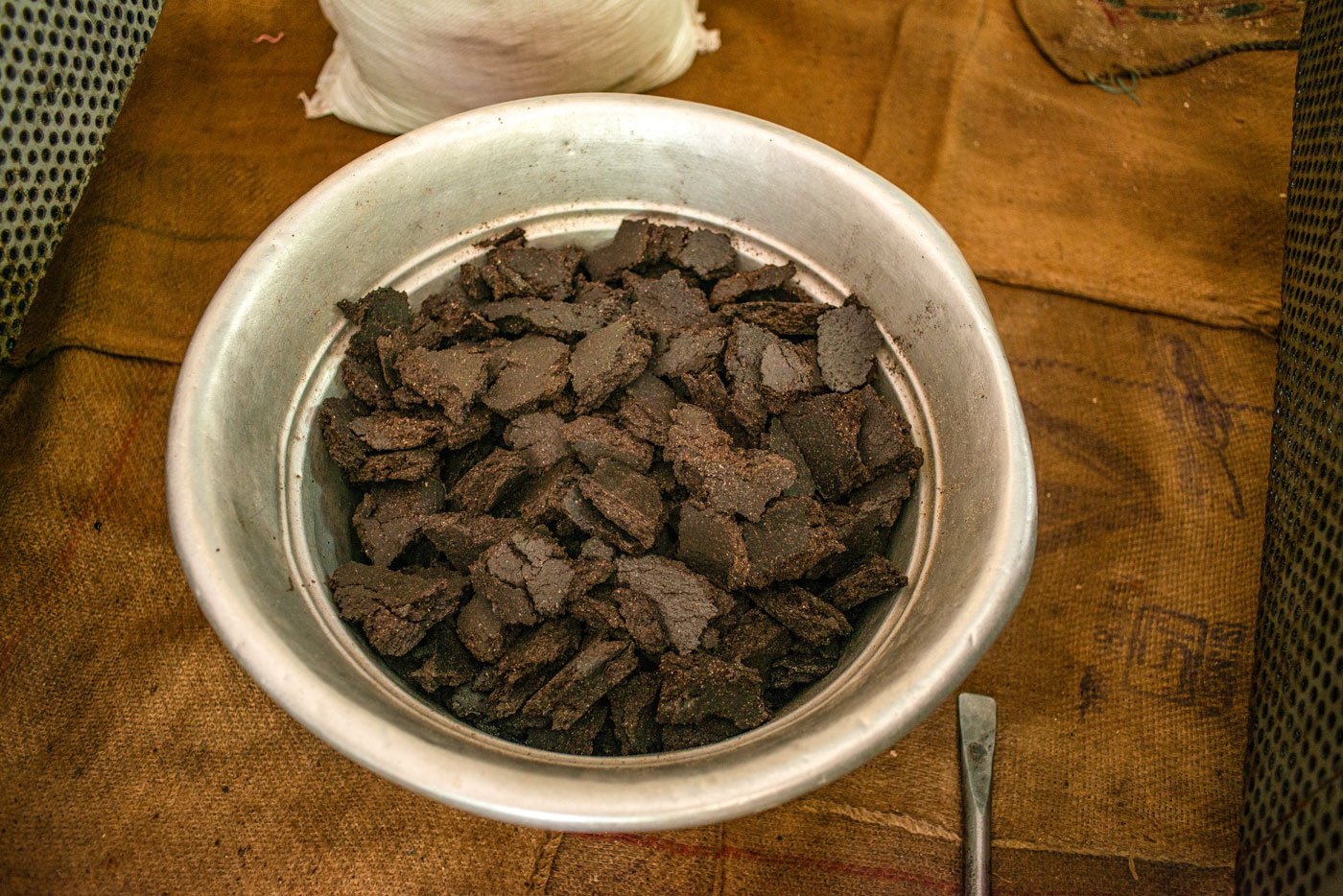
Freshly
pressed sesame oil (left) sits in the sun until it clears. The de-oiled cake,
ellu punaaku
(right) is sold as feed for livestock
‘Sesame ( Sesamum indicum L .) is the oldest indigenous oilseed crop, with the longest history of cultivation in India.’ The Handbook of Agriculture, published by the ICAR goes on to add that India is the largest producer of sesame in the world, accounting for 24 per cent of the land worldwide where the crop is grown. It also notes that India accounts for 12 to 15 per cent of the world’s oilseeds area, 7 to 8 per cent of the output and 9 to 10 per cent of global consumption.
This isn’t some modern phenomenon, though. K.T. Achaya, in his pioneering work Indian Food, A historical companion notes that there is plenty of evidence regarding its export.
Historic descriptions of the sesame trade from south Indian ports date back to at least the 1st century CE. The Periplus Maris Erythraei (Circumnavigation of the Erythrean Sea), authored by an unknown Greek-speaking Egyptian sailor writing from first-hand experience, records great details of the trade of that time. He mentions, that among the precious commodities sent abroad – including ivory and muslin – were sesame oil and gold, both from Kongunadu, in the western part of present-day Tamil Nadu. The pairing seems to indicate the stature of the oil.
Local trade, Achaya notes, was vibrant too. A picture of the town of Madurai in the Mathuraikkanchi written by Mankudi Maruthanar conveys the excitement of the marketplace: ‘Sacks of pepper and sixteen kinds of grains such as paddy, millet, gram, peas and sesame seeds are heaped in the grain merchant’s street.’
Sesame oil had royal patronage. Achaya’s book Indian Food mentions Domingo Paes, a Portuguese merchant who lived for several years in Vijayanagar around 1520. Paes wrote about King Krishnadevaraya:
“The king is accustomed to drink a three-quarter pint
of gingelly (sesame) oil before daylight and anoints himself with the same oil;
he covers his loin with a small cloth and takes in his hand great weights, and
then taking his sword exercises himself till he has sweated out all the oil.”
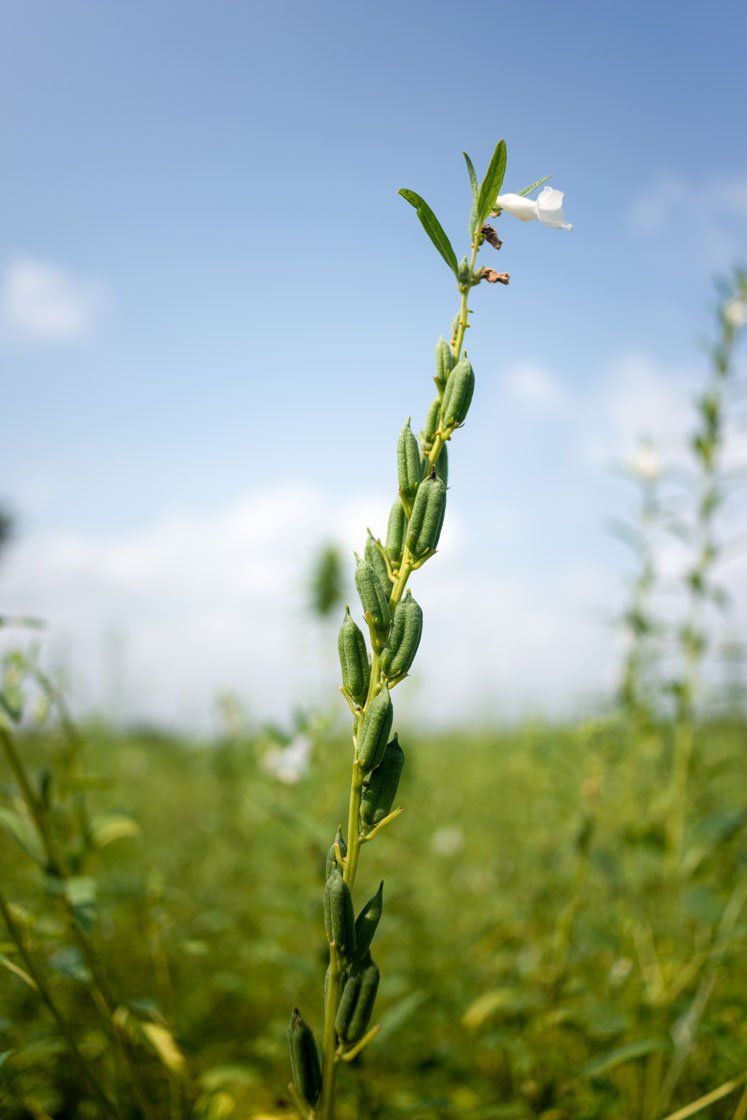
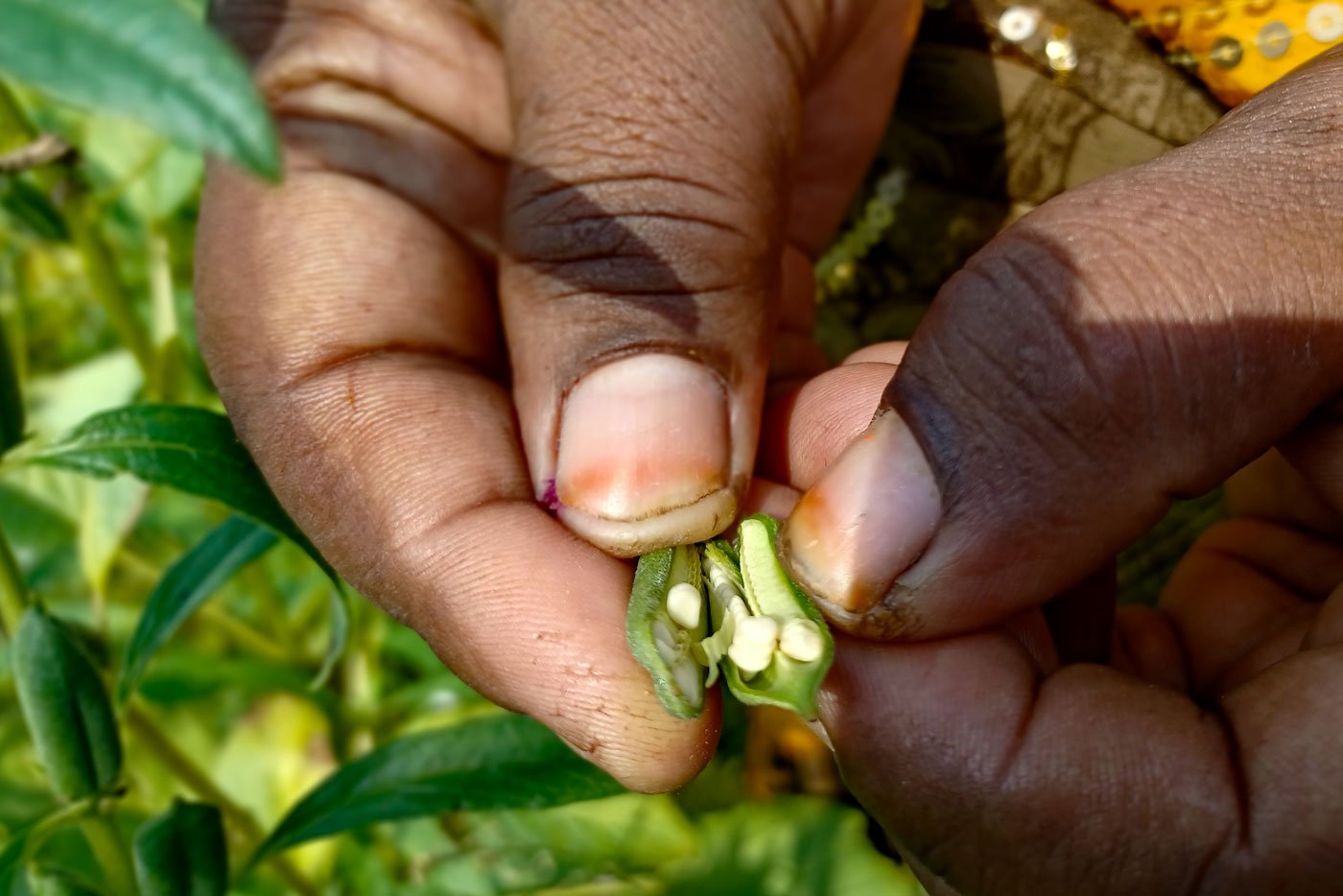
Sesame flowers and pods in Priya's field (left). She pops open a pod to reveal the tiny sesame seeds inside (right)
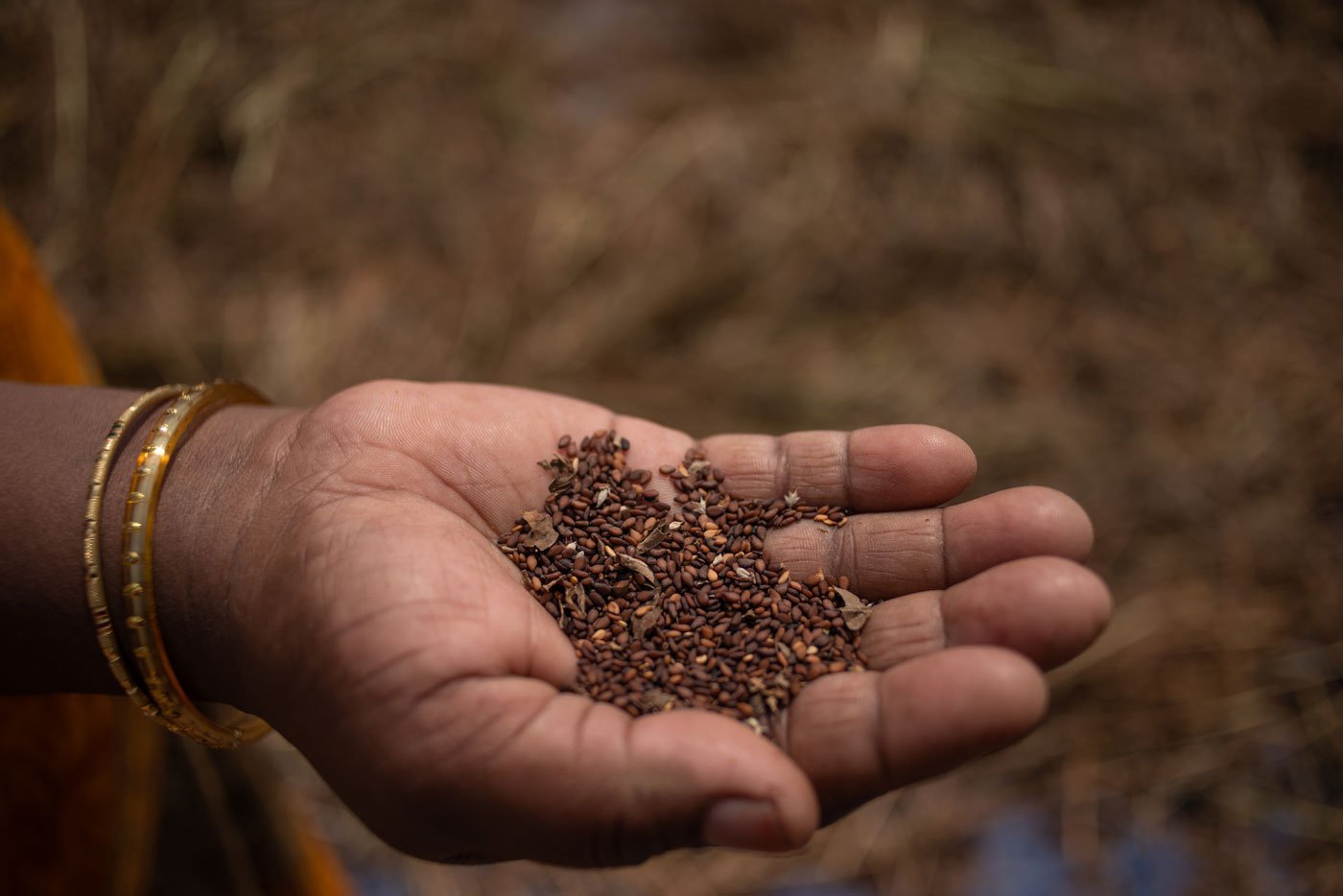
Priya holding up a handful of sesame seeds that have just been harvested
Vadivelan’s father Palanivel would have approved. He seems, from every description, to have been a sports-loving man. “He maintained his physique carefully. He lifted stones [weights], taught kushti in the coconut grove. He also knew Silambam [ancient martial art of Tamil Nadu mentioned in Sangam literature] very well.”
The family only used sesame from their fields for oil, and occasionally coconut oil. Both were stored in large vessels. “I remember so well, my father used to drive a Raleigh cycle, and load it with sacks of black gram and go to Gandhi Market in Trichy. He’d come back with chilli, mustard, pepper and tamarind. It was like a barter. And the kitchen would be stocked for the year!
*****
Vadivelan and Priya got married in 2005. Their wedding was held in the Vayaloor Murugan temple, near Trichy. “My father did not come, he did not approve of our marriage,” Vadivelan says. “To make it worse, my friends who came to the village to pick up my relatives promptly went and asked my father if he was coming. He got furious!” Vadivelan bursts out laughing.
We’re seated in the couple’s house, in the hall, next to a shelf full of pictures of gods. On the wall, there are photos of the family – selfies, holidays, portraits, and a television which is Priya’s escape, when she can find the time. The kids are away when we visit, both at school. Their dog comes to say hullo. “That’s Julie,” Vadivelan says. “She’s pretty,” I admire her. “It’s a boy,” Vadivelan grins. Julie walks away unhappily.
Priya invites us to eat. She’s prepared a feast, with
vadai
and
payasam
. She serves us on a plantain leaf. The food is delicious.
And heavy.
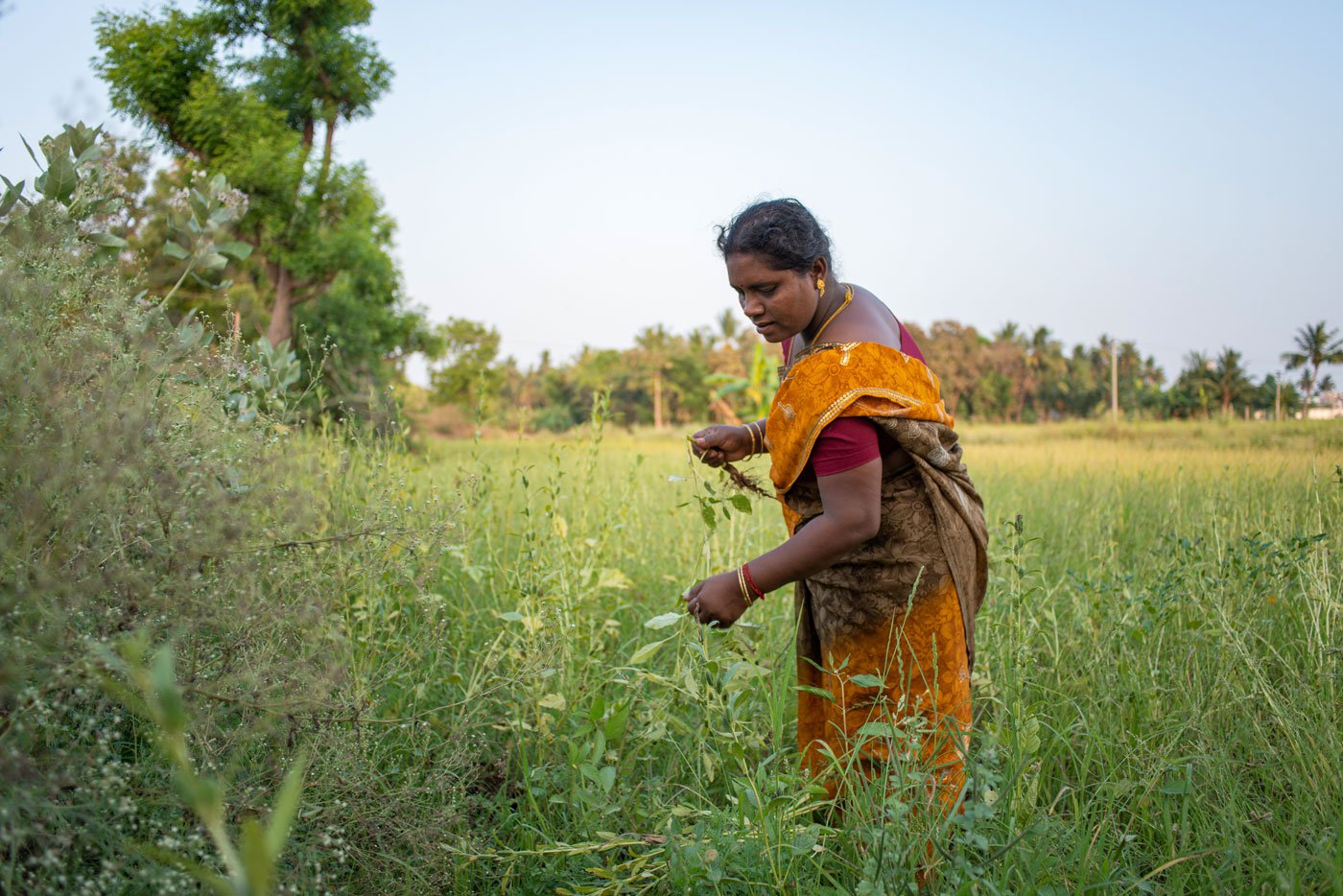
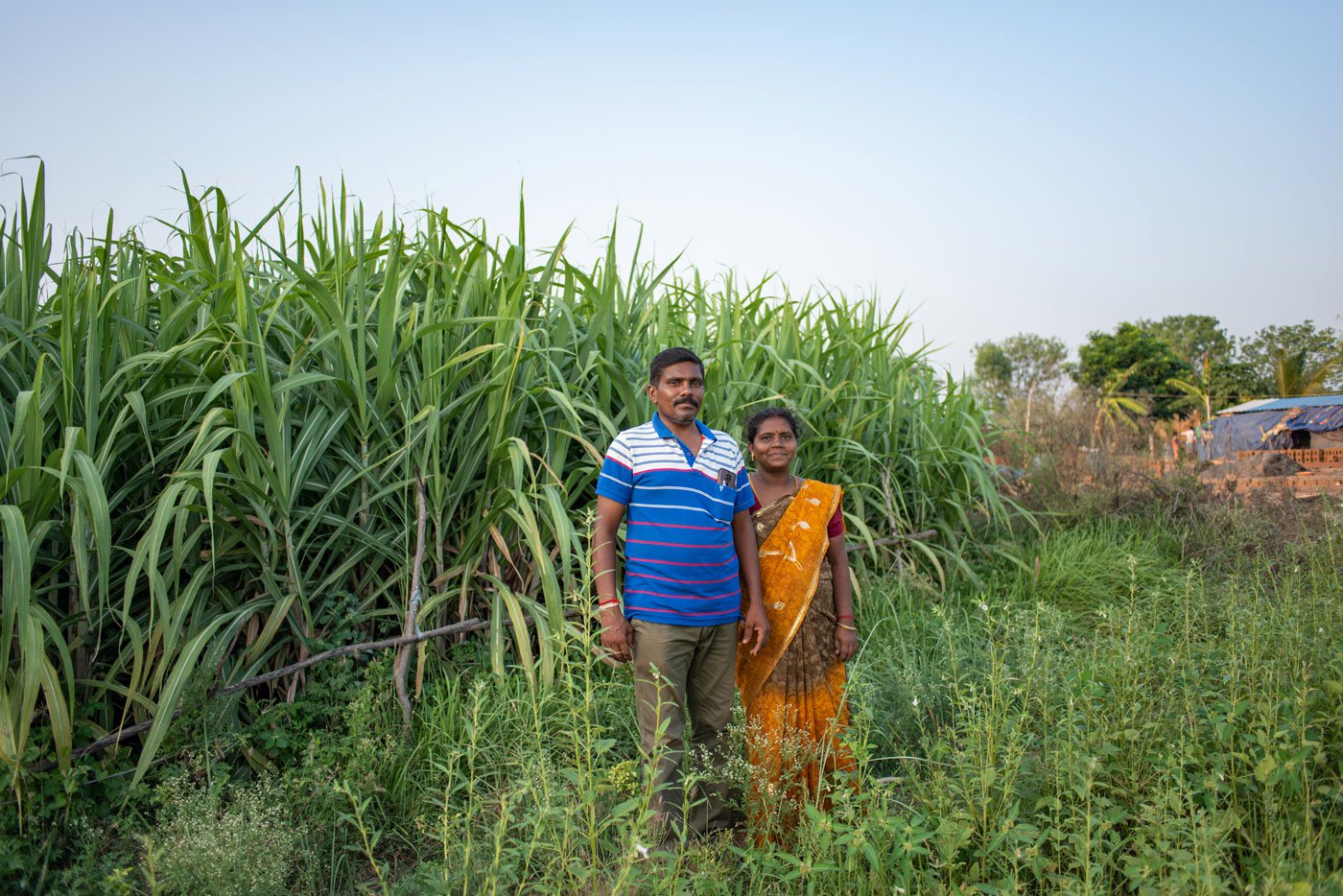
Left: Priya inspecting her sesame plants. Right: The couple, Vadivelan and Priya in their sugarcane field
To stay awake, we talk business. What is it like to raise sesame? “Frustrating,” says Vadivelan. Farming itself is, he points out. “Returns are poor. But input prices keep going up. Urea is so expensive, as are the other fertilisers. Then we have to plough the field, sow the sesame seeds. Next, we have to raise furrows, so that water flows in between. And we only irrigate the field when the sun is down.”
The first proper watering is around the third week, Priya explains. By then, the plant is so high, she holds her hands nine or 10 inches off the ground. “Then it starts growing quickly. In the fifth week, you remove the weeds, add urea, and irrigate it every 10 days or so. If there’s good sunshine, you’ll get a good yield.”
While Vadivel goes to work, Priya watches the fields. At any time, they have at least two crops in their one and a half acres. She wraps up the house work, sends the kids to school, packs a meal for herself and drives her bicycle to join the labourers in her field. “At 10 in the morning, we need to buy everybody tea. And after lunch, it is tea and palakaram [snacks]. Usually we get suiyam [sweet] and urulai bonda [a savoury].” She zips up and down, fetching, carrying, bending, lifting, cooking, cleaning... “Have some juice,” she says, before we leave to see their fields.
*****
The ellu vayal , sesame field, is a thing of beauty. The flowers are delicate, almost ornamental, and they come in shades of pink and white, reminiscent of chiffon sarees and French manicures. Hardly the stodgy oil that’s the staple of south Indian kitchens.
The sesame plant is tall and thin, with dark green leaves. There are many green pods on the stem. Each is as big as an almond, and shaped like a cardamon. Priya pops one for us. Inside, there are several small pale white sesame seeds. It’s tough to imagine how many of these need to be crushed for a spoonful of oil. Why, a single idli is typically coated with at least two, and some idli podi (a dry chutney).
It’s hard to think straight though – the April sun is ferocious. We seek out a little shade in a grove nearby. This is where the women agricultural labourers too rest, Vadivelan says. Many of them are hard at work in his neighbour Gopal’s black gram field. They’ve wrapped cotton towels over their heads, to protect themselves from the great heat of the day. They work without pause, with breaks only for lunch and tea.
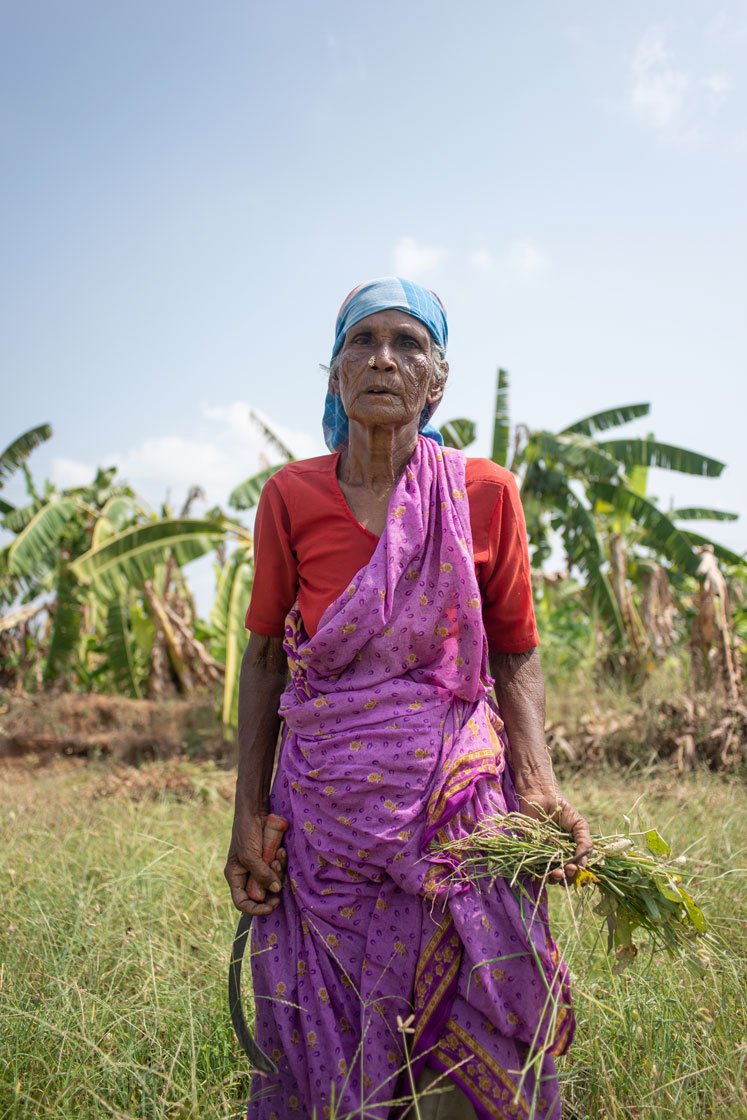
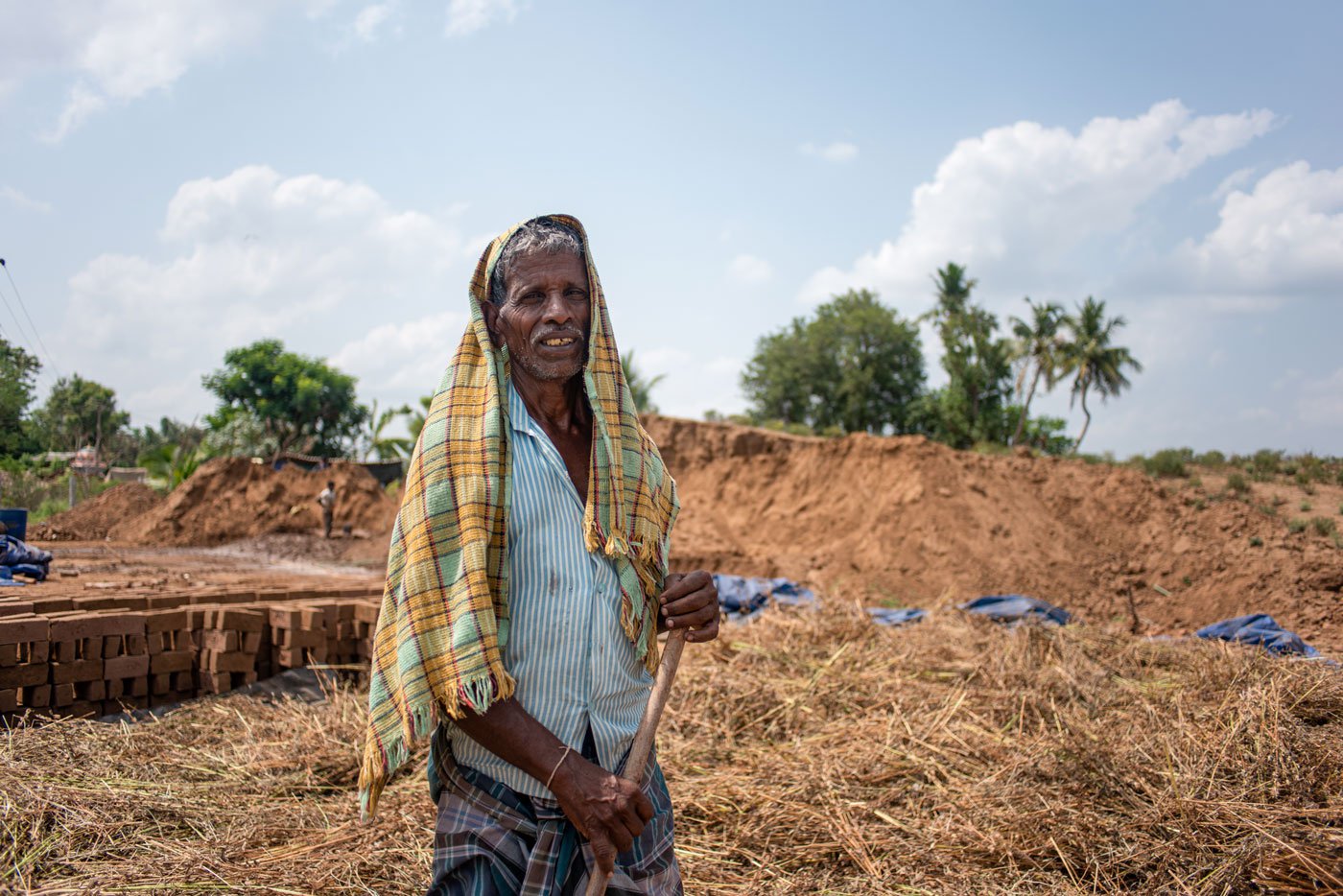
Left: Mariyaayi works as a labourer, and also sells tulasi garlands near the Srirangam temple. Right: Vadivelan’s neighbour, S. Gopal participates in the sesame harvest
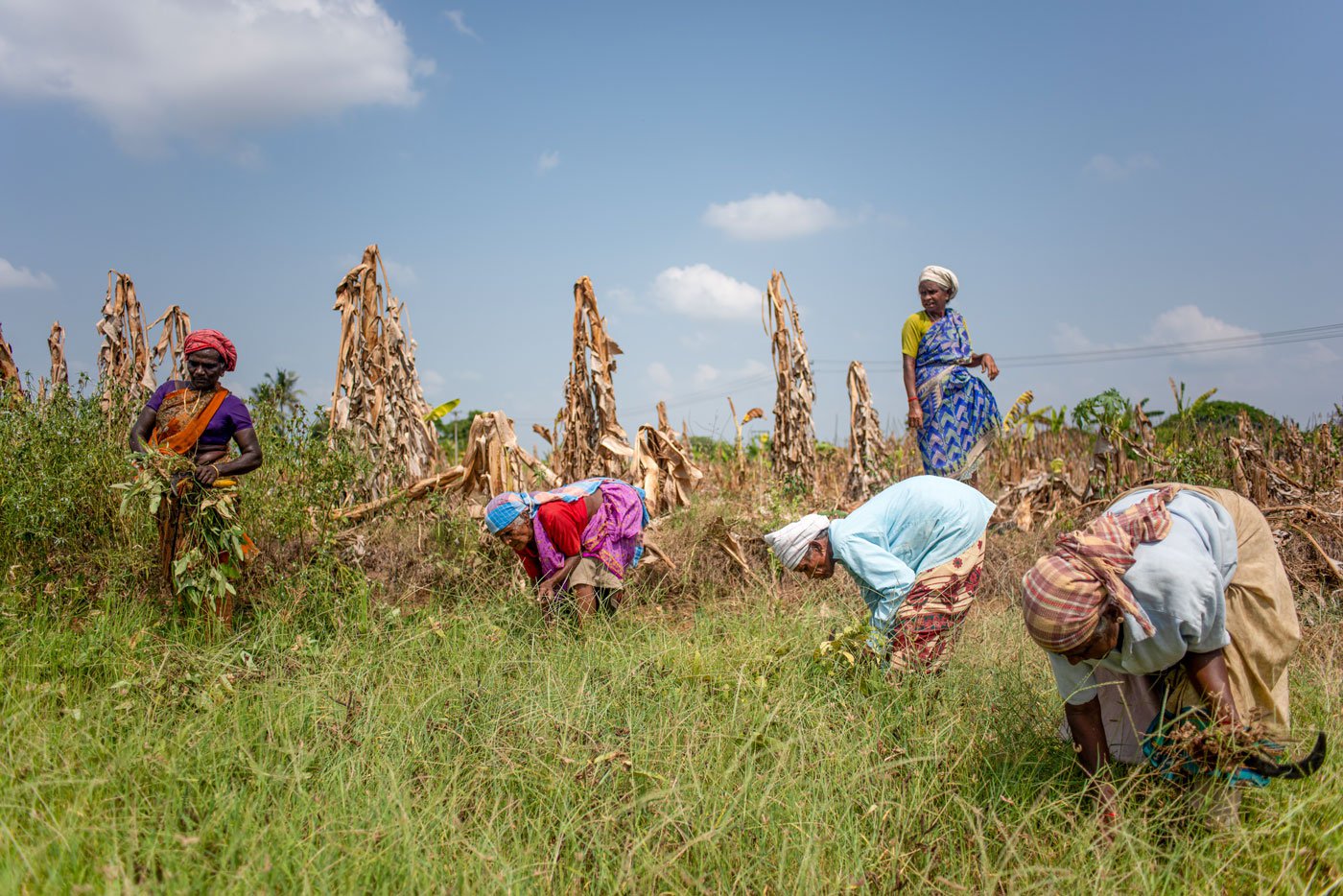
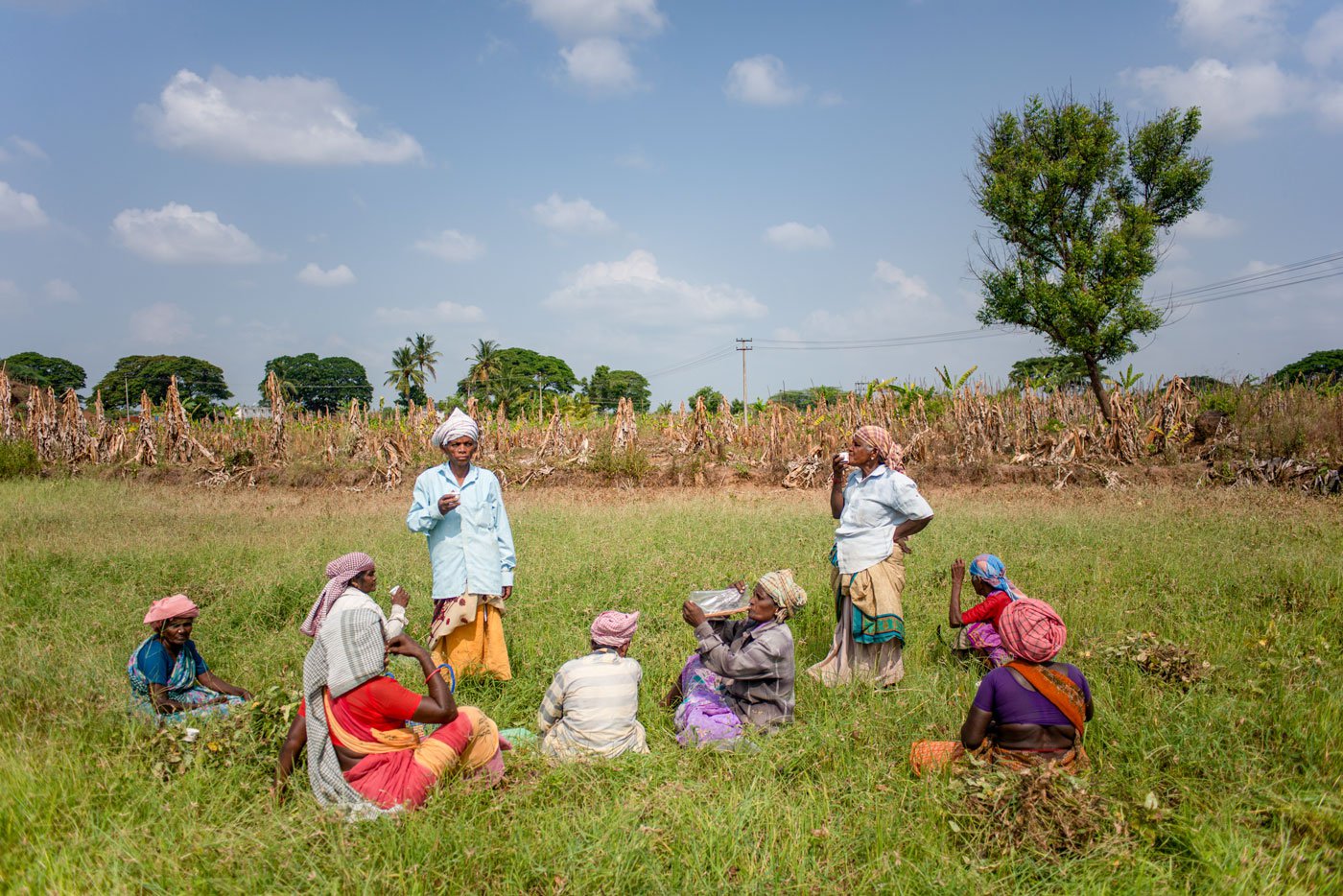
Women agricultural labourers weeding (left) in Gopal's field. They take a short break (right) for tea and snacks
All of them are older women. The oldest, perhaps, is V. Mariyaayi, in her seventies. When she’s not weeding or transplanting or harvesting, she takes tulasi (holy basil) garlands to the Srirangam temple and sells them there. She speaks softly. The sun blazes. Relentlessly…
The sesame plant apparently doesn’t mind the sun. It doesn’t mind a lot of things, Vadivelan’s neighbour S. Gopal, 65, tells me. And Vadivelan and Priya agree. The three farmers barely talk about pesticide and sprays – those are only mentioned in passing – and neither do they fret about water. Sesame is by all accounts similar to millets – easy to raise, requiring little attention. What can damage it is unseasonal rain.
And that’s what happened in 2022. “It rained when it shouldn’t – in January and February when the plant was young, stunting the growth,” says Vadivelan. He is close to harvesting the field, but only expects a very small yield. “We got 150 kilograms from the 30 cents (a third of an acre) we planted last year. This time, I doubt it will cross 40 kgs.”
This quantity, the couple estimates, will barely meet their annual oil need. “We grind the seed in batches of about 15 to 18 kilograms. That fetches us around seven or eight litres of oil. We need at least two batches, to get by,” explains Priya. Vadivelan promises to take us to an oil-mill the next day. But what about the seeds? How are they collected?
Gopal kindly invites us to watch. His sesame field is a little away, next to a brick kiln where many migrant families live and work – earning the grand sum of one rupee a brick. It’s where they raise their children (who in turn raise goats and poultry). The kiln is quiet in the evening. And M. Seeniammal, a brick kiln worker, walks over to help.
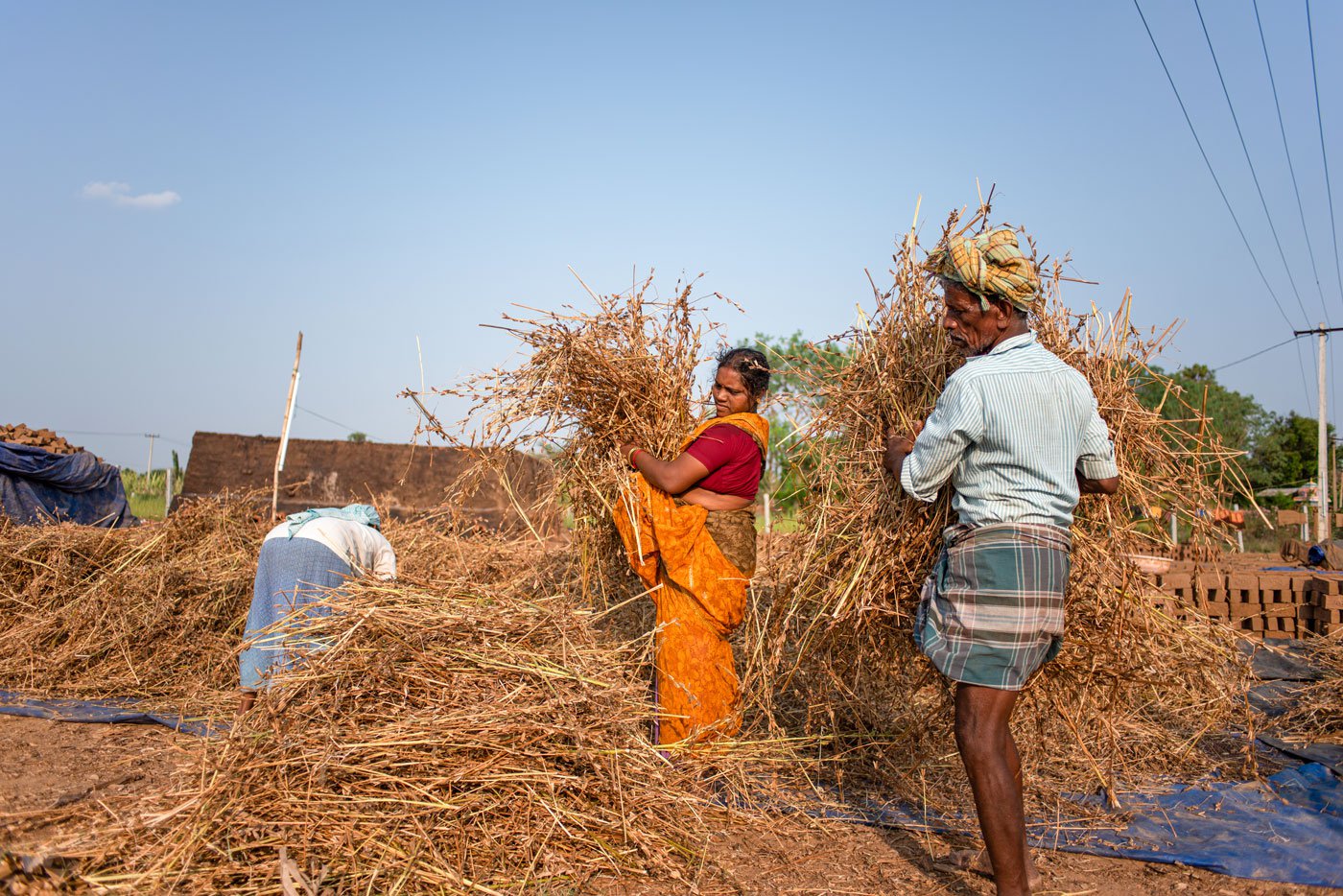
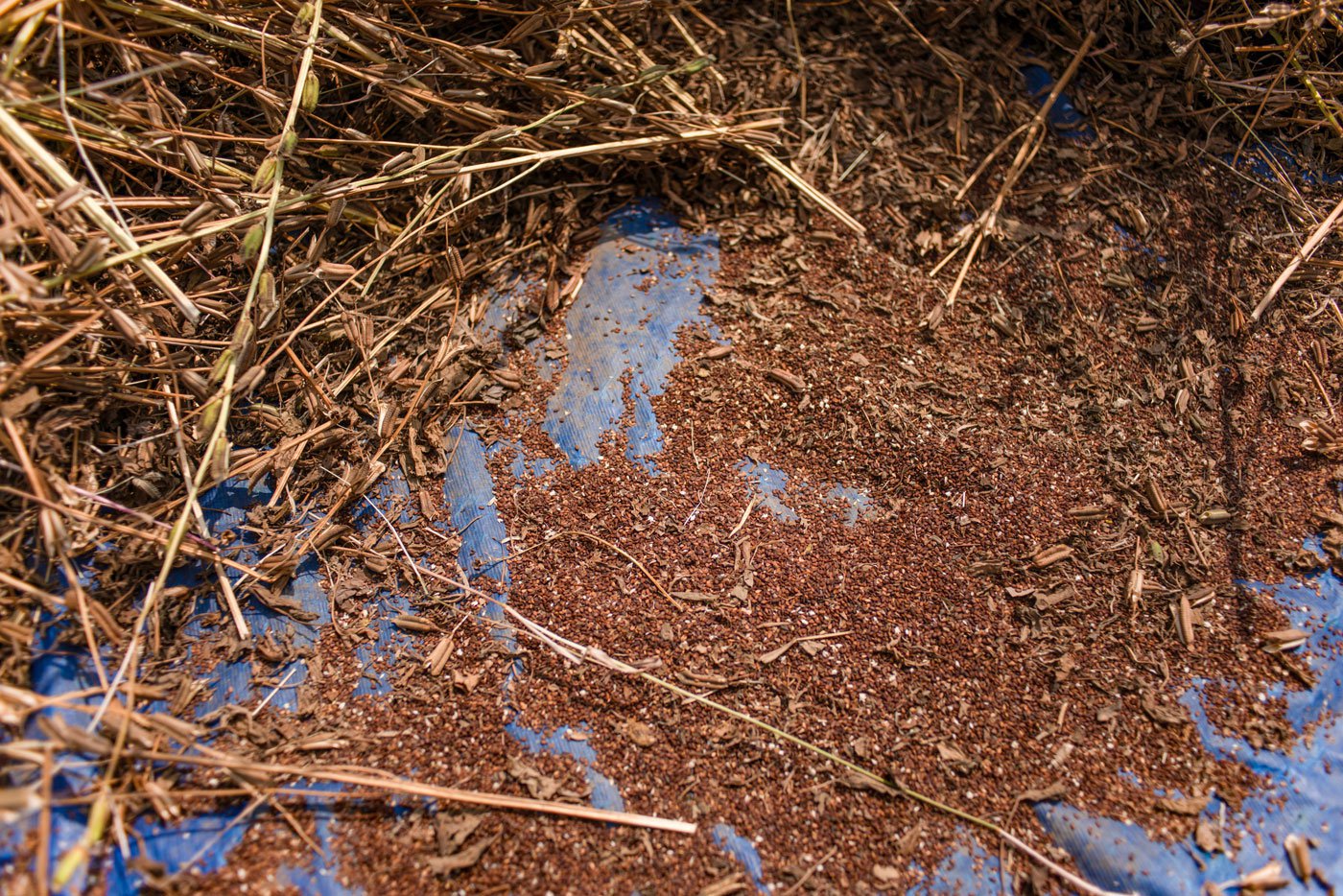
Priya and Gopal shake the harvested sesame stalks (left) until the seeds fall out and collect on the tarpaulin sheet (right)
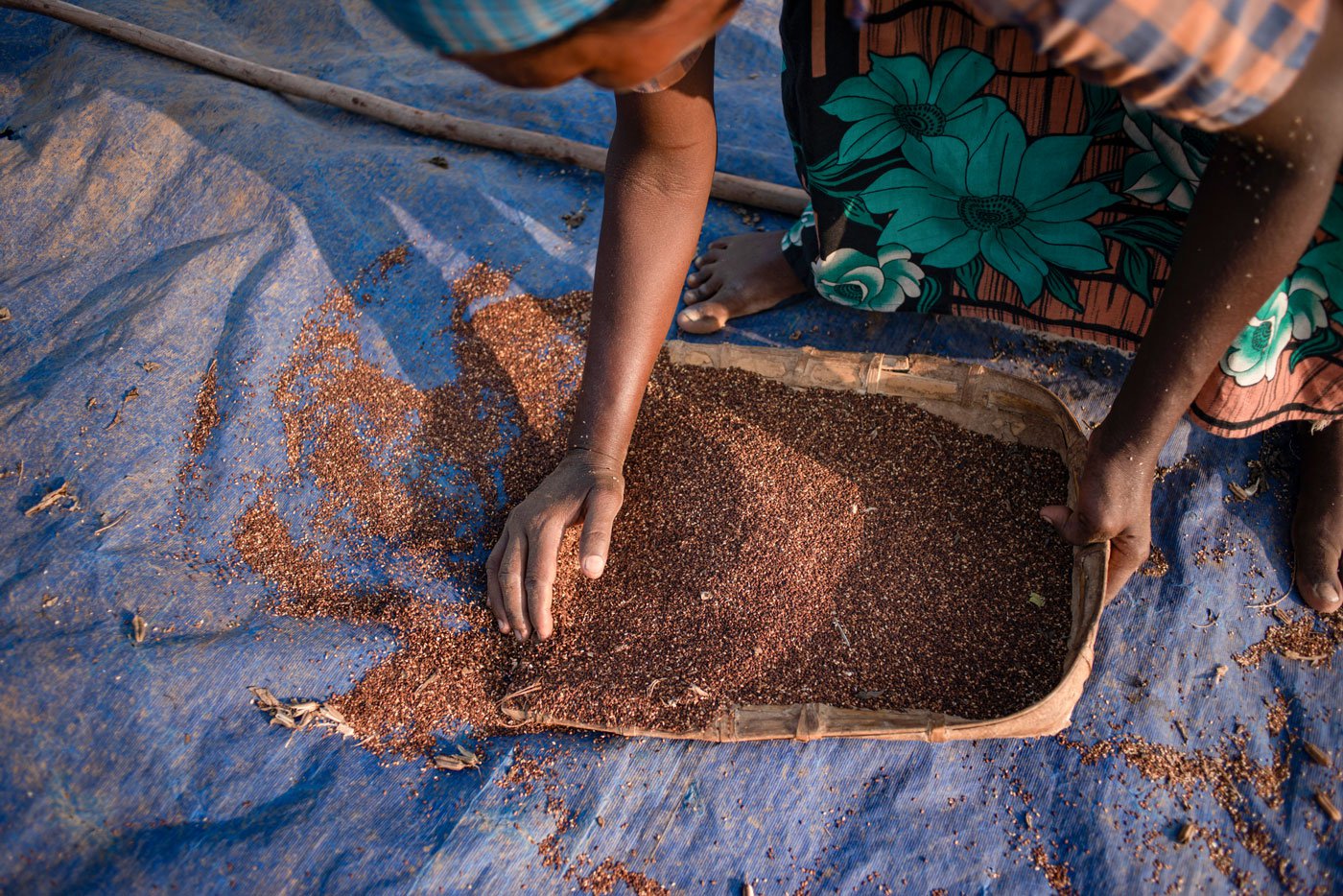
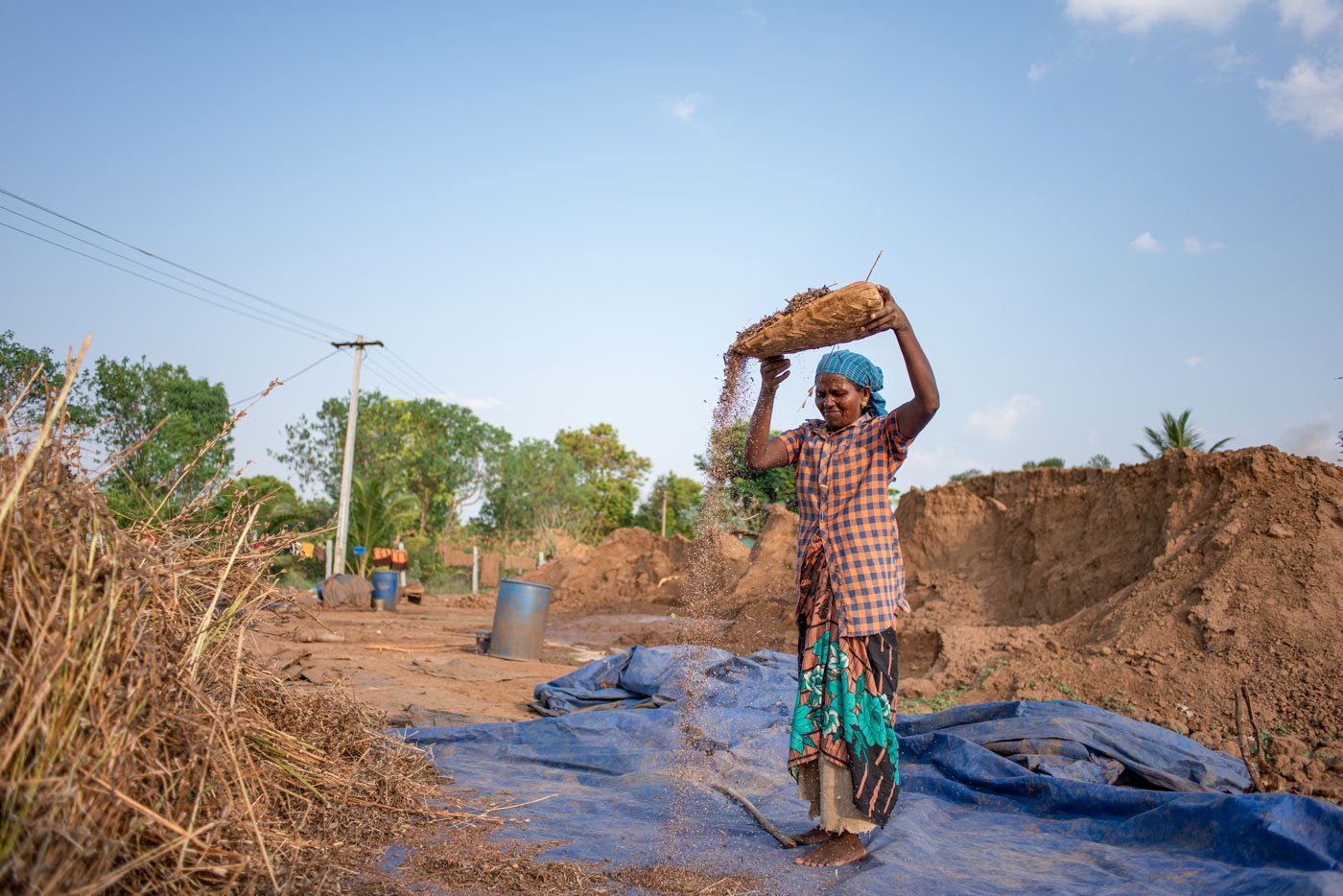
Sesame seeds collected in the winnow (left). Seeniammal (right) a brick kiln worker, helps out with cleaning the sesame seeds to remove stalks and other impurities
First, Gopal removes the tarpaulin that covers the harvested sesame plants. They’ve been heaped together for a few days, to increase temperature and humidity and encourage the seeds to pop. Seeniammal turns the stalks over expertly with a stick. The pods are ripe and ready; they burst and the mature seeds fall out. She gathers them with her hands and makes little mounds. And repeats the process until all the stalks are empty.
Priya, Gopal and others collect the stalks and bundle them. They no longer serve as fuel. “I remember they were used to boil paddy. But we get that done in the rice mill now. Sesame stalk is simply burnt,” Vadivelan explains.
Many old practises have vanished, Gopal continues. He’s especially upset that the concept of uyir veli (live fencing) has disappeared. “When we had them, jackals lived in burrows along the hedges. And they kept a check on birds and animals which ate up our crops. You just don’t see jackals now!” he laments.
“Very true,” Vadivelan agrees. “There were jackals everywhere. Before I got married, I picked up a pup near the river bank, thinking it was some kind of fluffy dog. My father immediately said it looked a bit off. That night a group of adult jackals howled behind our house. I went back and left the cub where I found it!”
While we chat, Seeniammal transfers the sesame seeds – now mixed with straw and dried leaf – onto a winnow. She raises it over her head, and expertly shakes it. The process is at once graceful and vigorous. And skilled. The sesame falls like rain, like music.
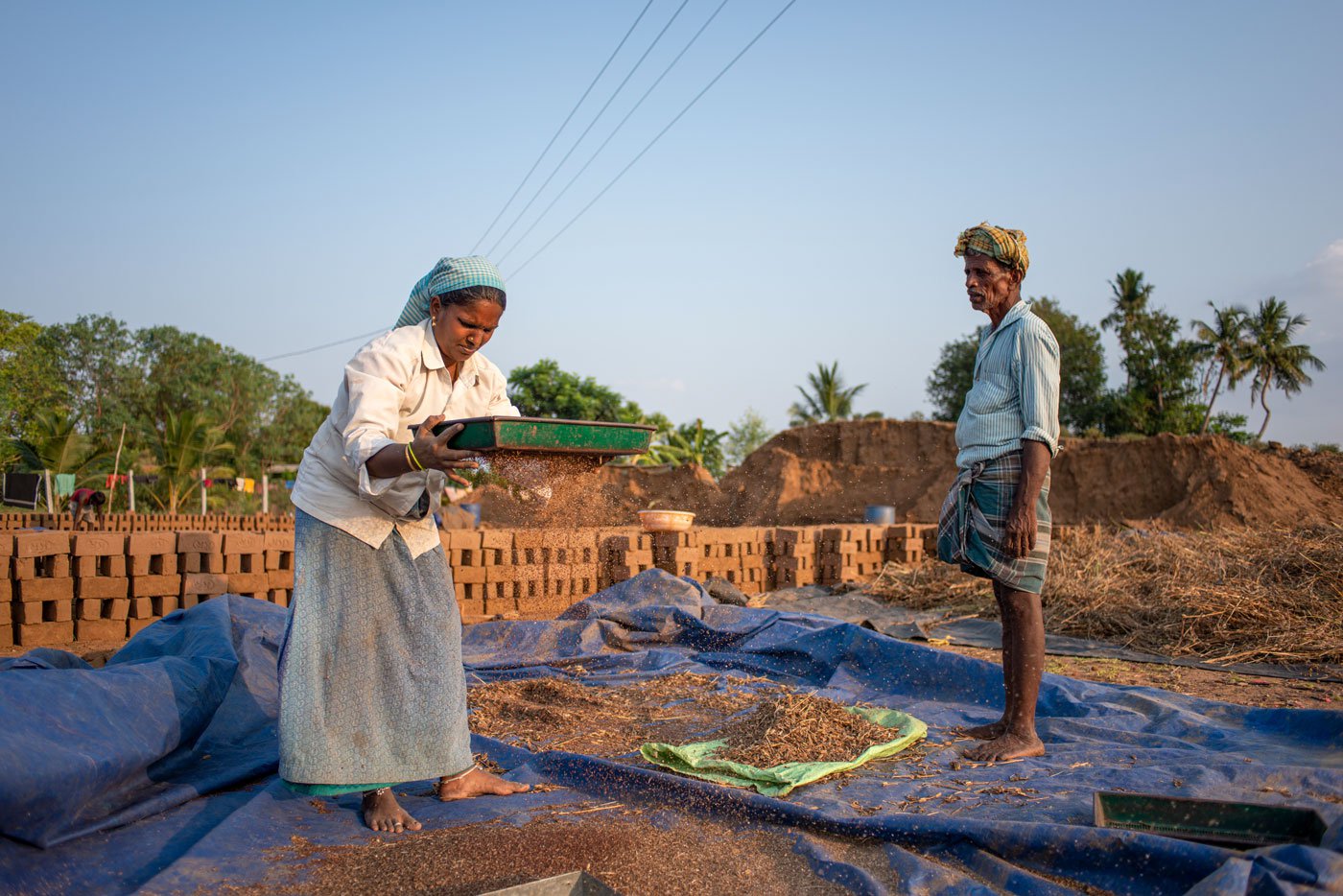
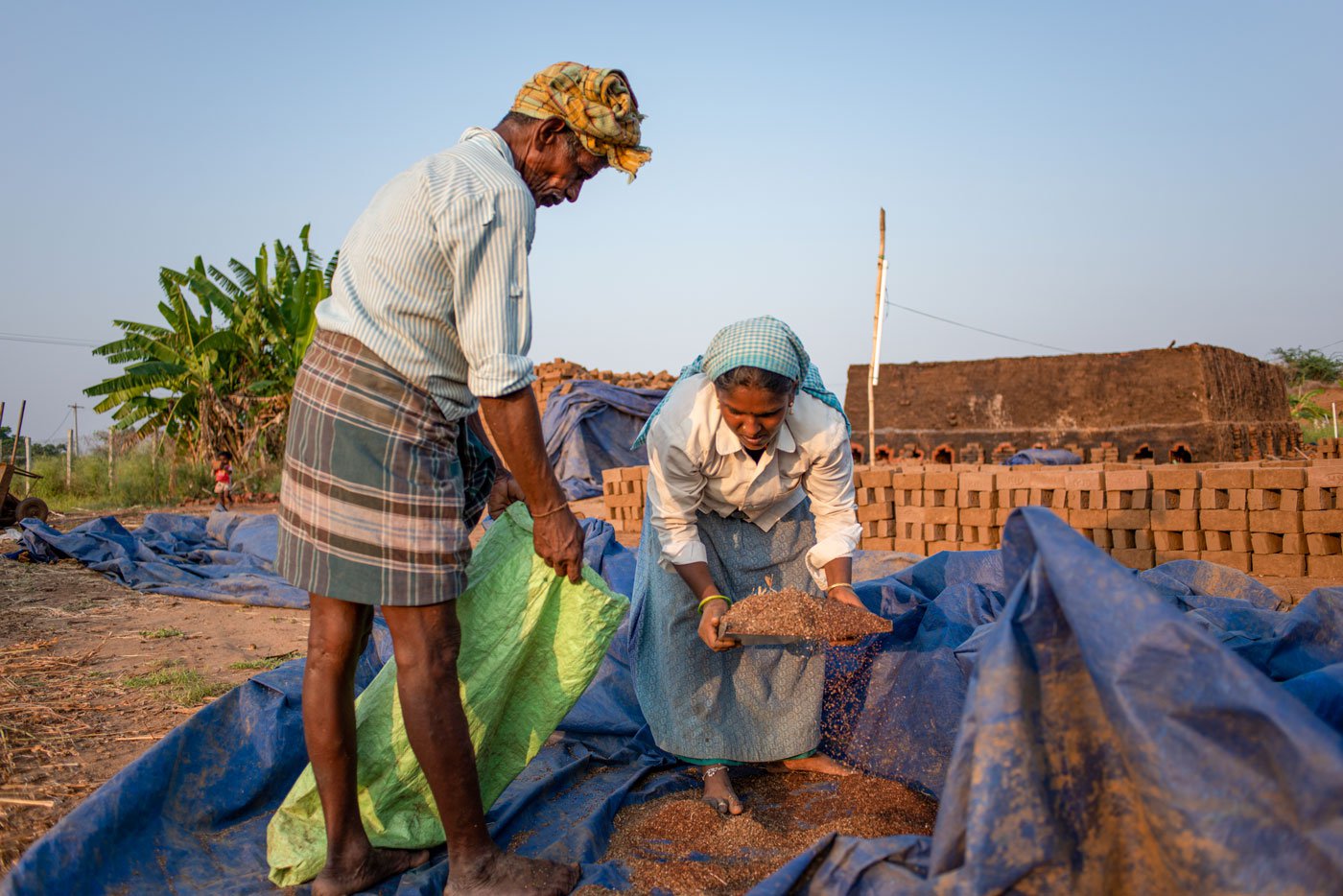
Gopal's daughter-in-law cleans the seeds using a sieve (left) and later they both gather them into sacks (right)
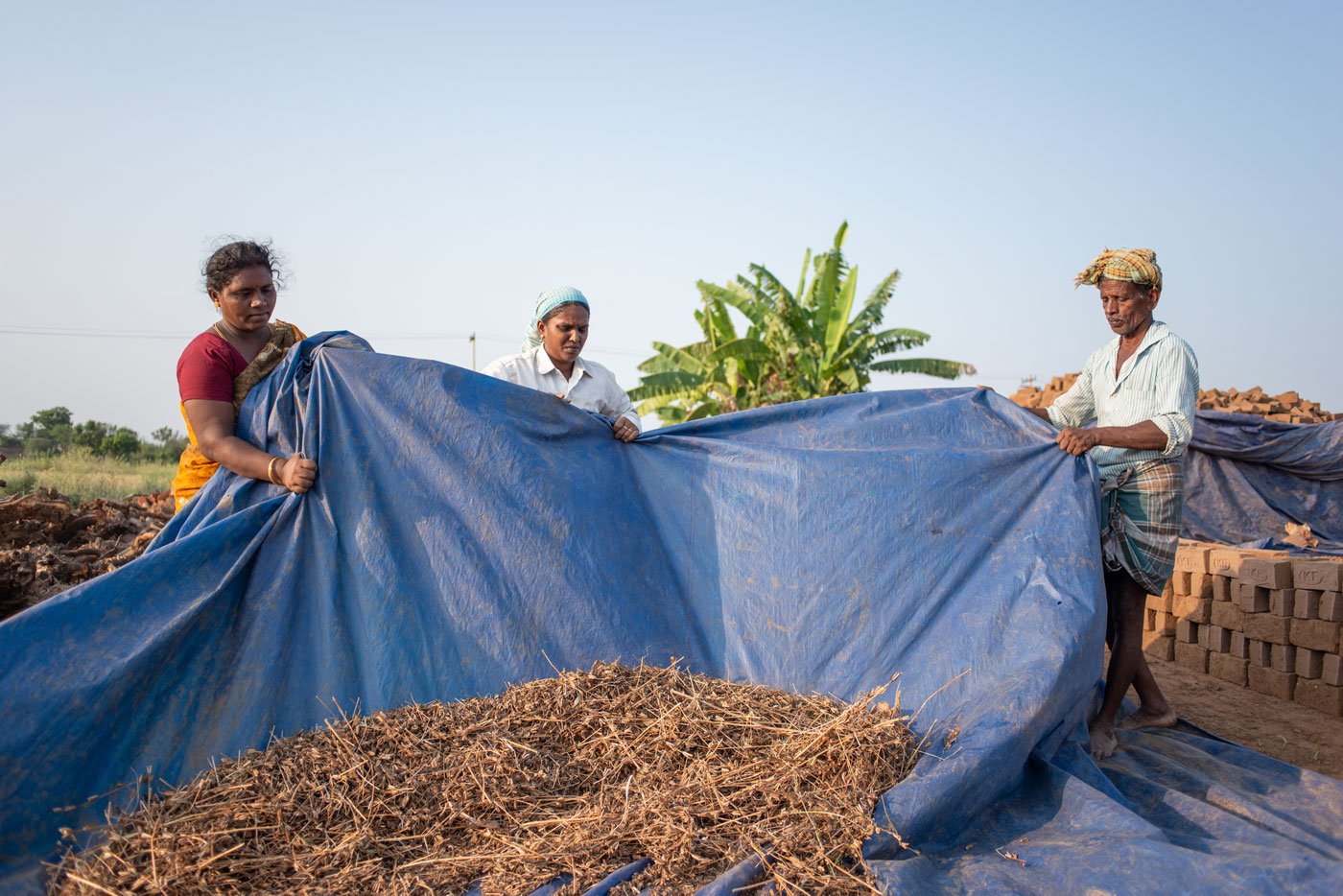
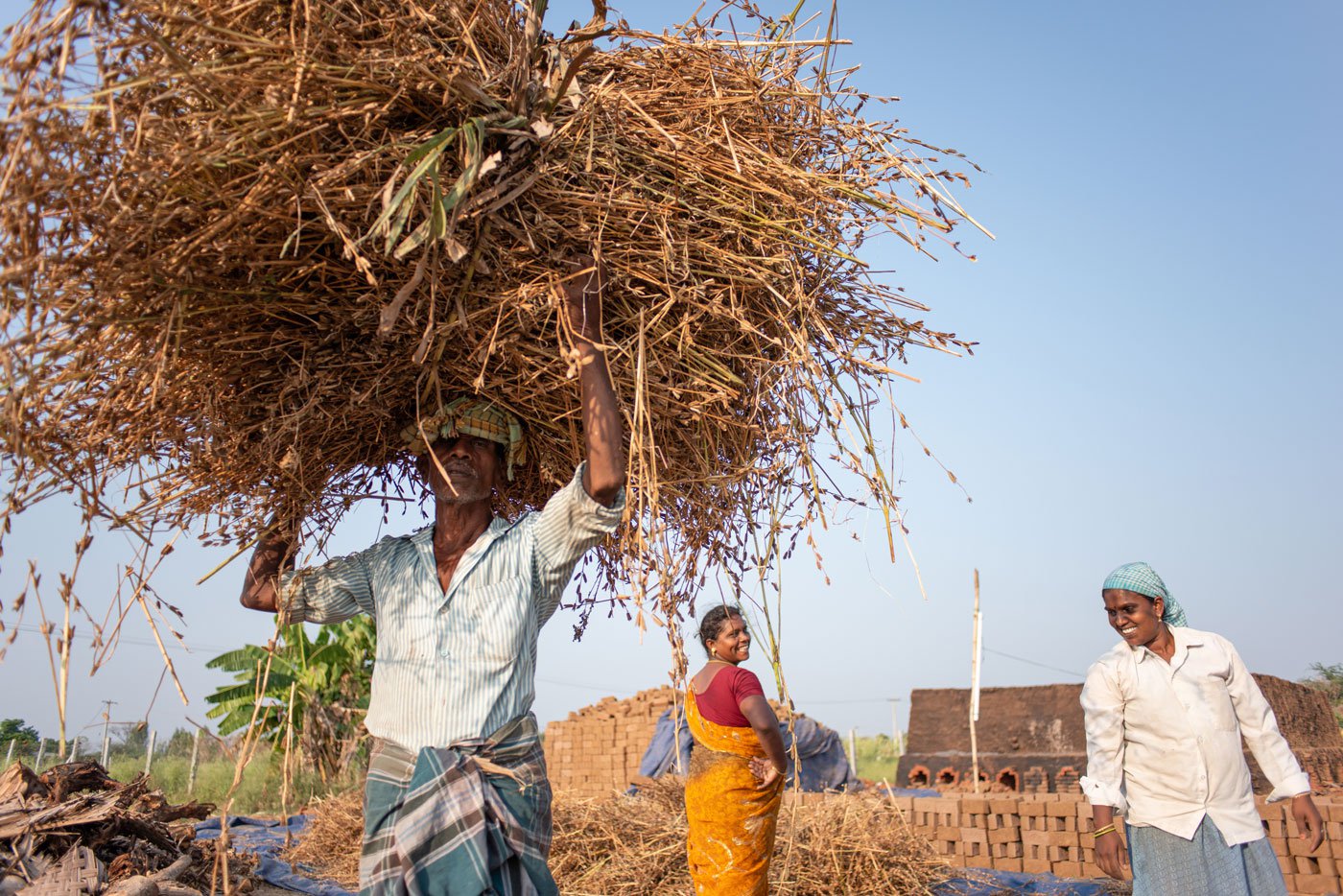
Priya helps gather the stalks (left). Gopal then carries it (right) to one side of the field. It will later be burnt
*****
An old Tamil song plays on the radio at Sri Ranga Marachekku (a wood press) at Srirangam. The owner R. Raju is seated behind the cash register. The mill whines as it crushes the sesame seeds. Big steel vessels brim with golden yellow oil. More sesame seeds dry in the backyard.
“It takes 1.5 hours to grind 18 kilos of sesame seeds. We add 1.5 kilos of palm jaggery to it. The yield is about 8 litres. Slightly less than what you’d get in a steel mill,” Raju explains. He charges clients 30 rupees to grind a kilo. And sells cold pressed sesame oil for Rs.420 a litre. “We only use first quality – bought directly from the farmer or from the Gandhi market at 130 rupees a kilo – and good quality palm jaggery at 300 rupees a kilo to enhance the flavour of the oil.”
The machine runs four times, between 10 a.m. and 5 p.m. and the freshly squeezed oil is kept out in the sun till it clears. The de-oiled cake ( ellu punaaku) has some residual oiliness, and farmers buy it at Rs. 35 a kilogram for their livestock.
Raju reckons he spends a little over Rs. 20,000 to farm, harvest, clean and bag an acre of sesame. The yield is typically upwards of 300 kilos of sesame. He calculates a profit between Rs. 15,000 to 17,000 an acre for this three-month crop.
And that’s where the problem lies, Vadivelan says. “You know who benefits from our labour? Traders. When the crop changes hands, they make twice the amount they paid us,” he alleges. “What is their value addition? ” he shakes his head. “That’s why we don’t sell sesame. We raise it for the house, for our own consumption. Enough…”
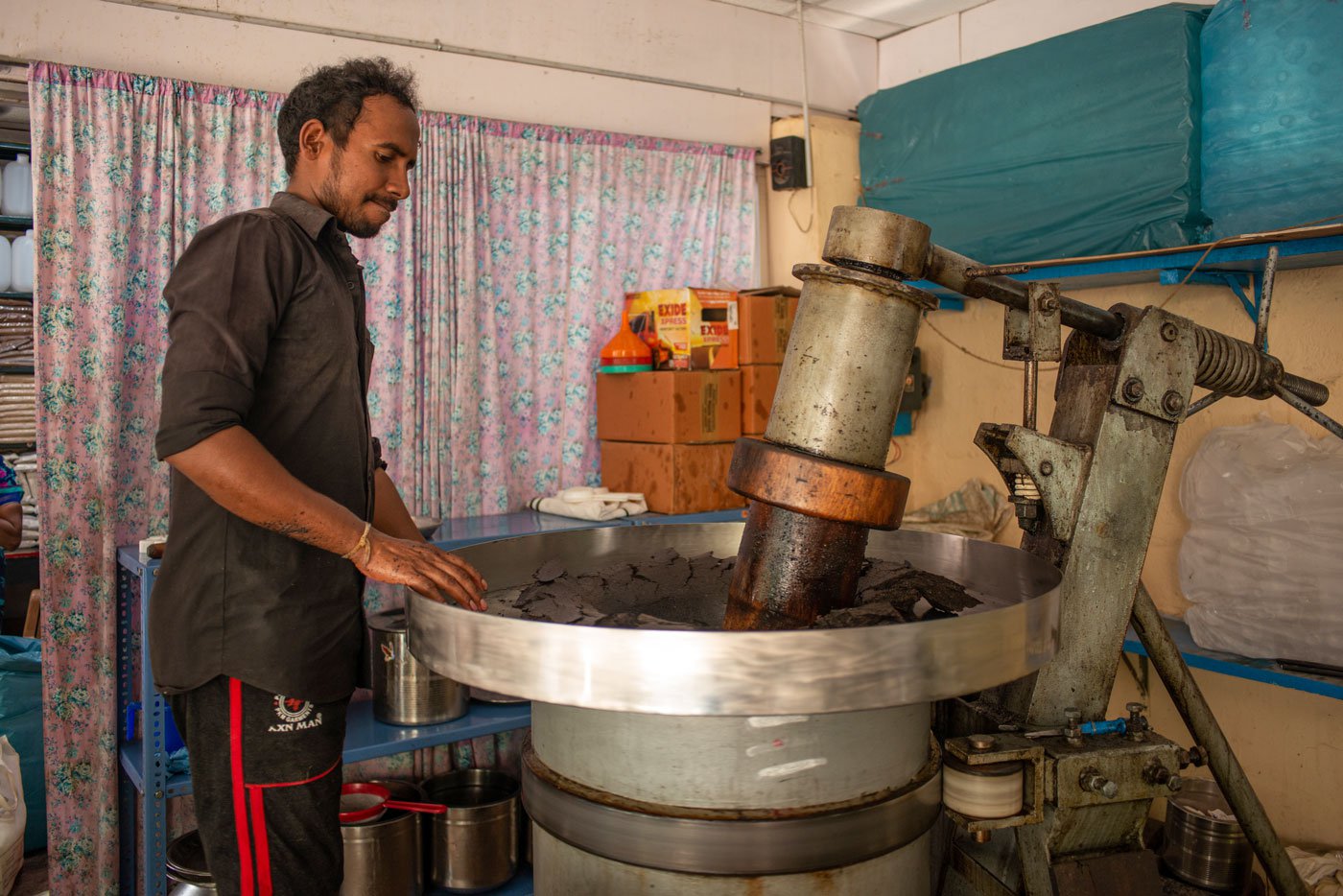
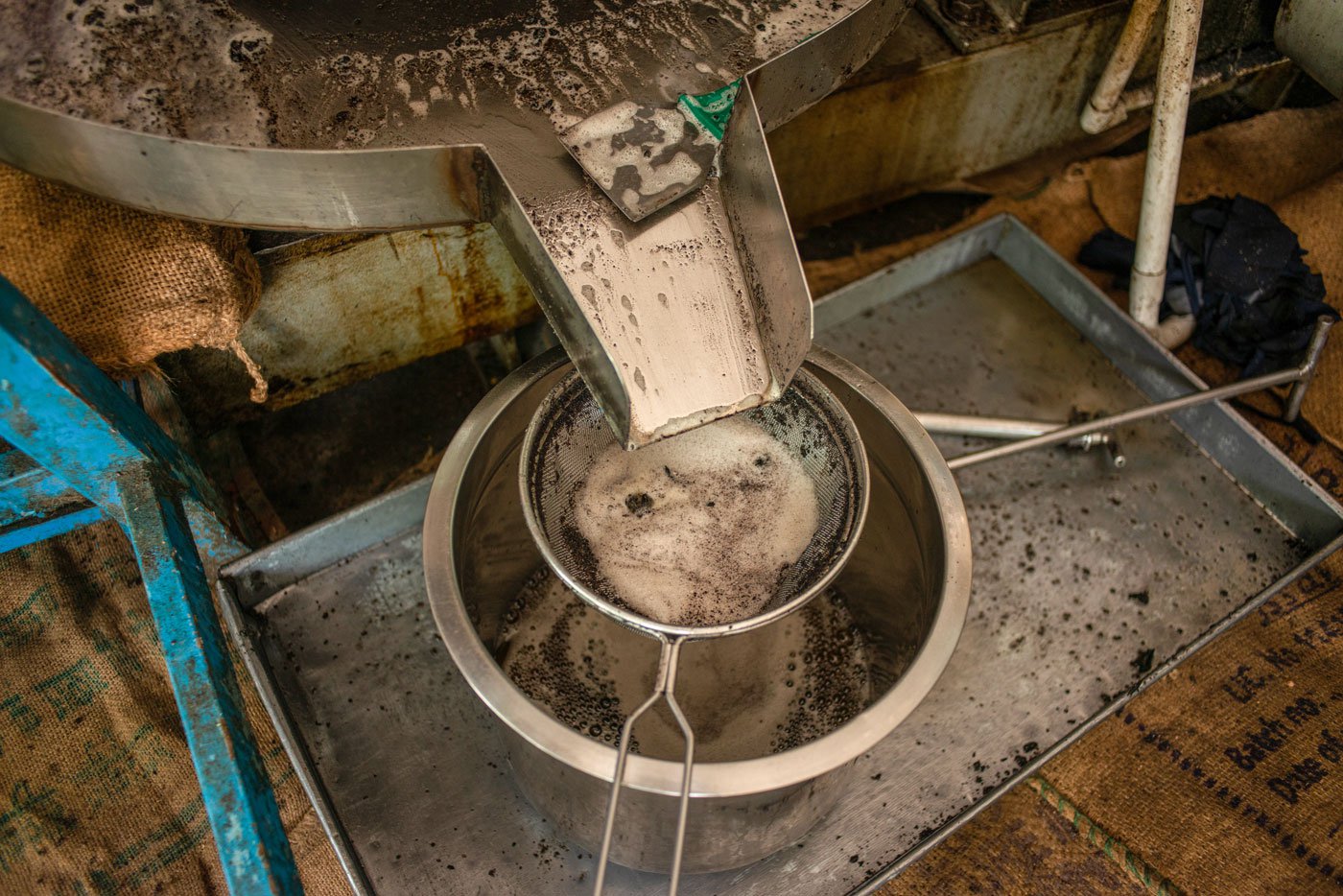
The wooden press at Srirangam squeezes the golden yellow oil out of the sesame seeds
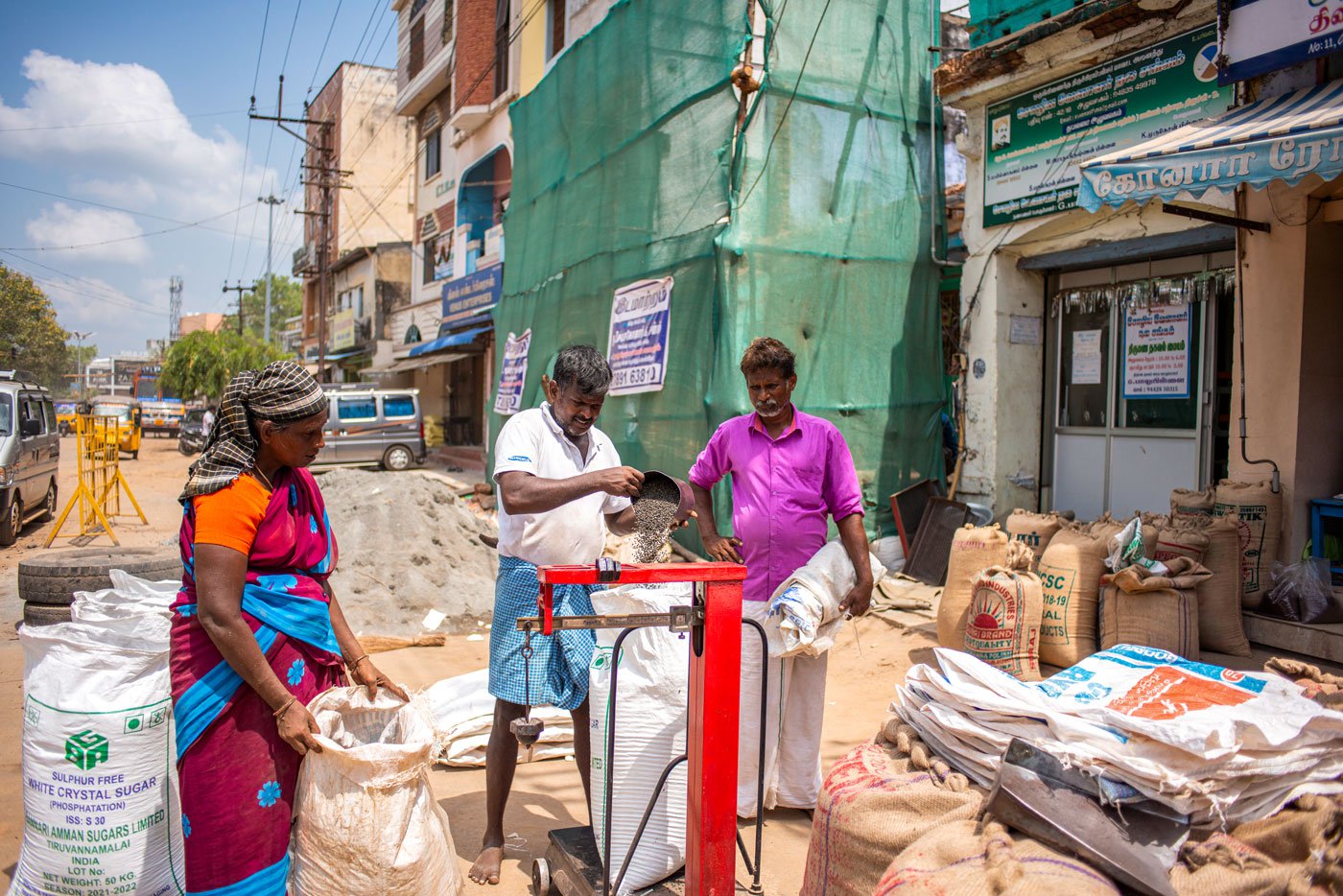
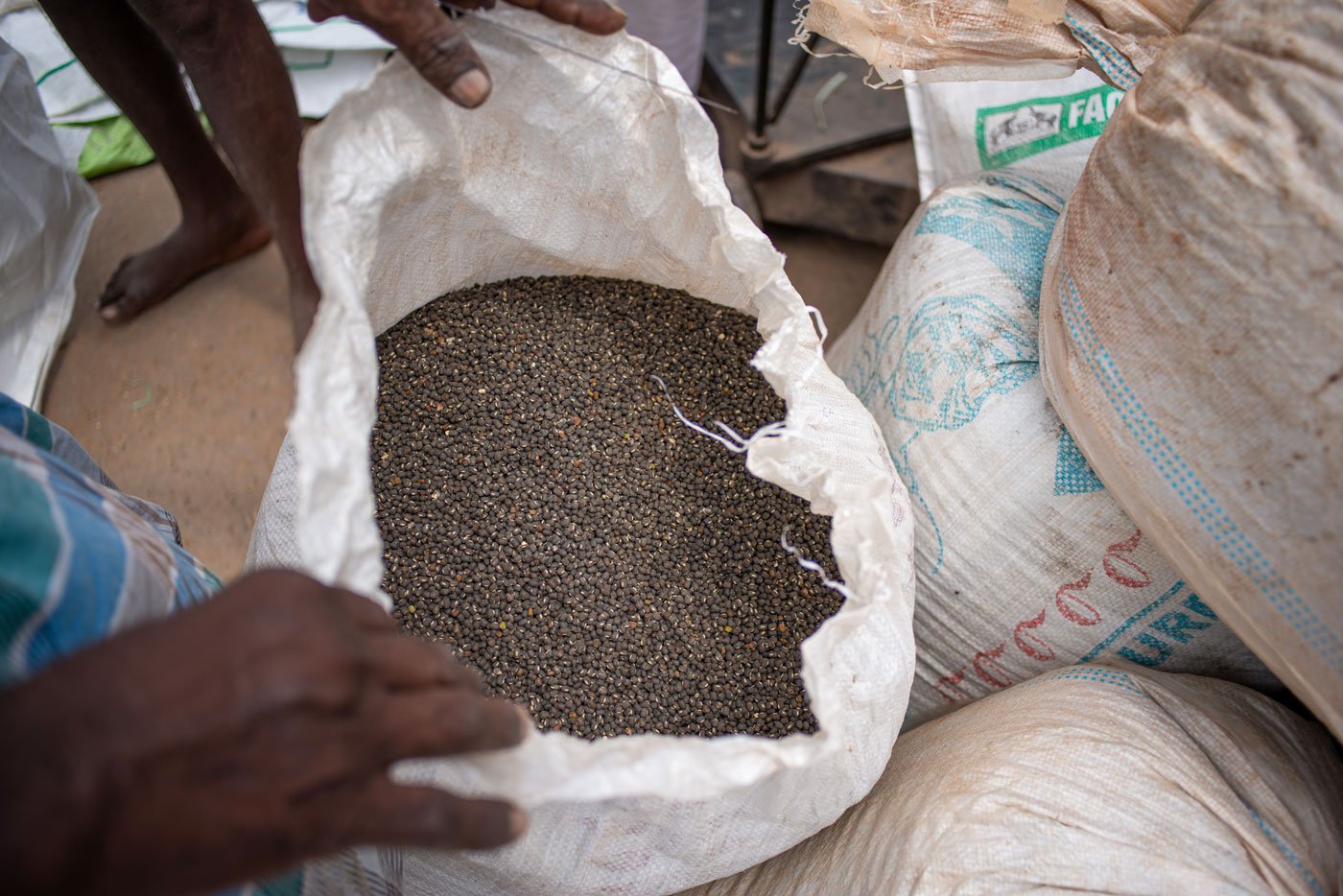
Gandhi market in Trichy, Tamil Nadu where sesame and dals are bought from farmers and sold to dealers
At Trichy’s busy Gandhi Market, the sesame shops are humming with activity. Farmers sit outside, on sacks of black gram, green gram and sesame. Traders are seated inside the cavernous shops that belonged to their grandfathers. P. Saravanan, 45, says there’s more black gram around the day we visit. Women and men labourers sieve and weigh and pack the dal . “The local sesame harvest has just begun,” he points out. “The sacks will start coming in soon.”
But even at its peak, S. Chandrasekaran, 55, estimates the output to be only a fourth of the crop they saw in his father’s time. “In June, there used to around 2,000 ellu mootai [sesame sacks] coming to Gandhi Market every day. The past few years, it’s down to 500. Farmers are quitting. This [crop] is so laborious. The price is not going up – it hovers between 100 and 130 rupees a kilo. So, they’re switching to black gram which can be harvested with a machine and stored in sacks on the same day.”
But the price of the oil is high, I point out, and only going up. Why don’t farmers get a better price? “It depends on the market,” Chandrasekaran replies, “on supply and demand, on the production in other states, on the stock that big oil mill owners pile up.”
It is the same story everywhere, for every crop and commodity. The ‘market’ is benevolent to some, and malevolent to others. It’s fairly obvious who it favours...
*****
The edible oil
industry has a long and complex history of imports and displacements: of crops
and cultural practices. As Dr. Richa Kumar, Associate Professor of Sociology
and Policy Studies at the Indian Institute of Technology, Delhi, explains in a
paper: “As of 1976, India was importing almost 30 per cent of its edible oil requirements.”
The paper, titled
From self-reliance to deepening distress
, goes on to say; ‘The government wanted to
duplicate the success of dairy cooperatives that had boosted milk production.”
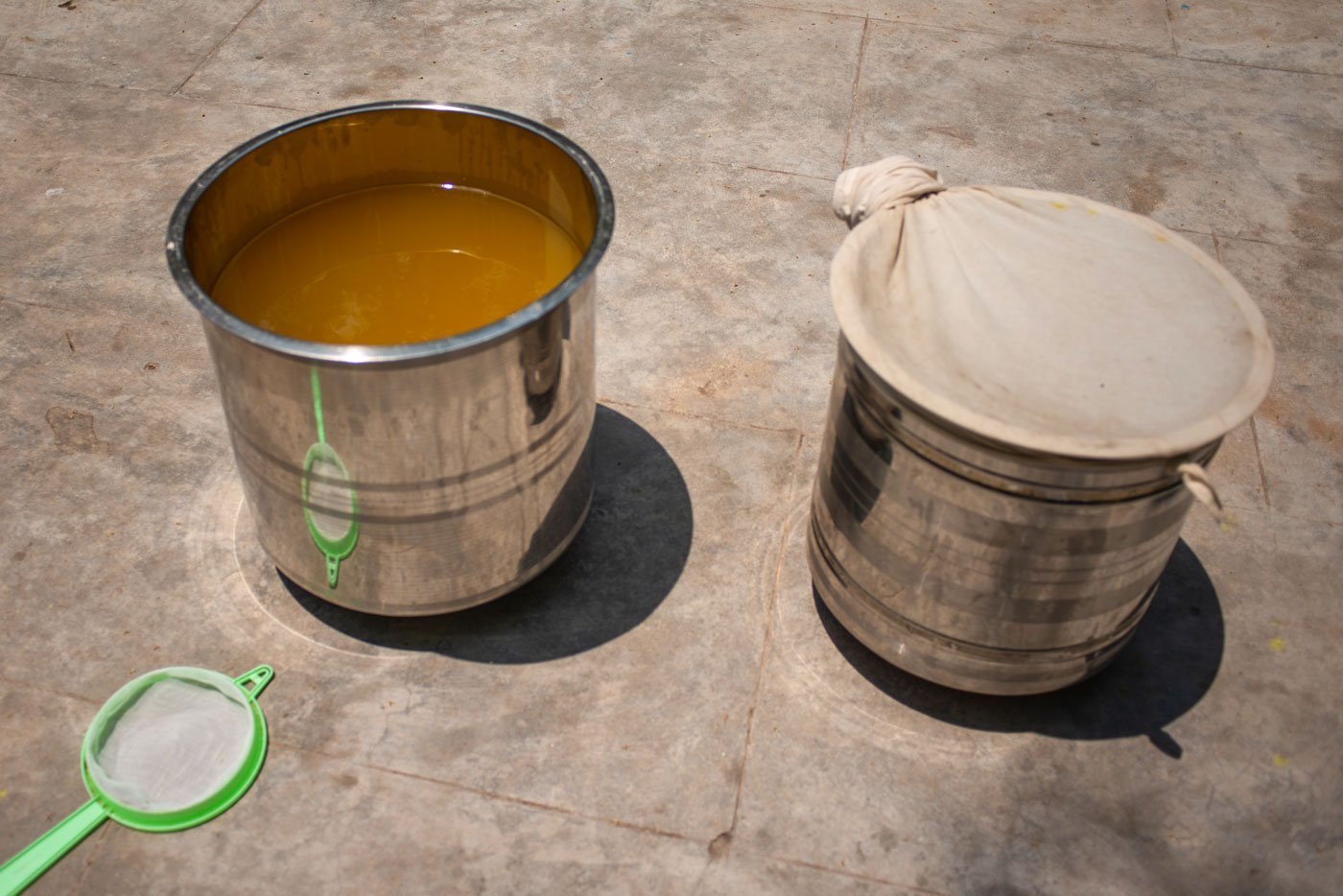
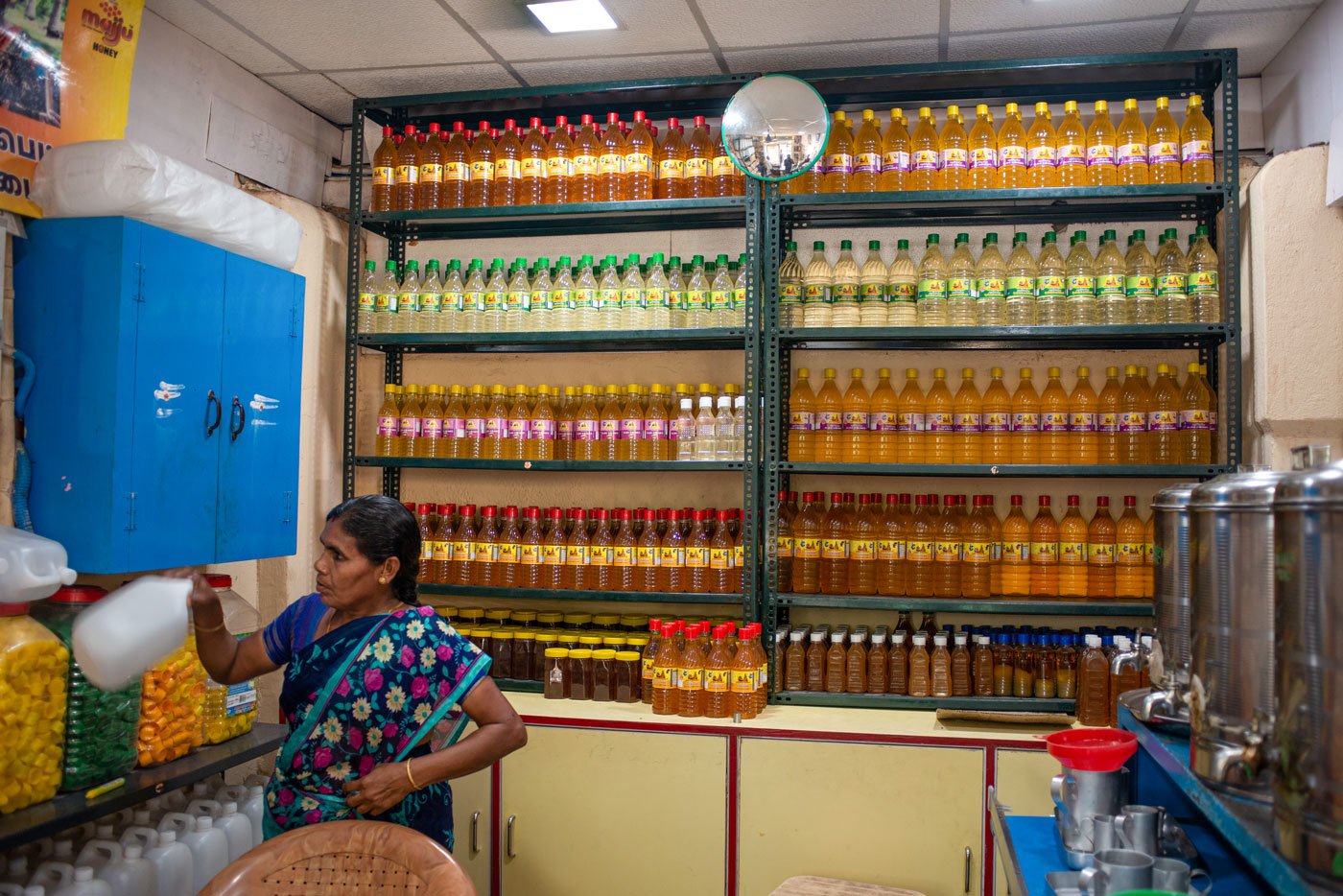
Freshly pressed sesame oil (left). Various cold pressed oils (right) at the store in Srirangam
But, points out Kumar, “despite the yellow revolution, India witnessed a growing scarcity of edible oil beginning in the mid-1990s, due to a shift of land away from mixed cropping of oilseeds-cereals-pulses to crops like wheat, rice and sugarcane that were given special incentives and purchase guarantees by the government. In addition, liberalisation of edible oil imports in 1994 paved the way for cheap palm oil from Indonesia and soybean oil from Argentina to flood the domestic market.”
“Palm oil and soybean oil became cheaper substitutes for other edible oils, especially in the manufacture of vanaspati (refined, hydrogenated vegetable shortening), a very popular substitute for more expensive ghee (clarified butter). Together, they displaced a multitude of traditional and regional oilseeds and oils from farms and plates across India including mustard, sesame, linseed, coconut and groundnut, as farmers found these crops unremunerative,” writes Kumar.
It's come to such a pass, that, edible oils are now the most imported commodity after petroleum and gold in India. They account for 40 per cent of the agricultural import bill and 3 per cent of the total import bill, says a paper published in June 2023, titled Pushing for Self-sufficiency in Edible Oils in India . It goes on to note that around 60 per cent of domestic consumption demand is met by imports.
*****
Sixty per cent of Vadivelan’s family’s expenses are met by his taxi. Like the Cauvery that splits into two just ahead of his village, Vadivelan’s time – and life itself – is divided between farming and driving. The former is tough, he explains. “It’s unpredictable and demanding.”
Because he has a day job (and drives for long hours), his wife pitches in with work in the fields. On top of the domestic work that’s mostly all hers. Vadivelan lends a hand often. Sometimes watering the field in the night, and running around for days to fetch a harvesting machine when they’re in great demand with everybody’s fields ripe for cutting. He used to do a lot of the heavy labour on the field. “But these days, I get a catch on my back if I work with the shovel and then I’m not able to drive the car!”
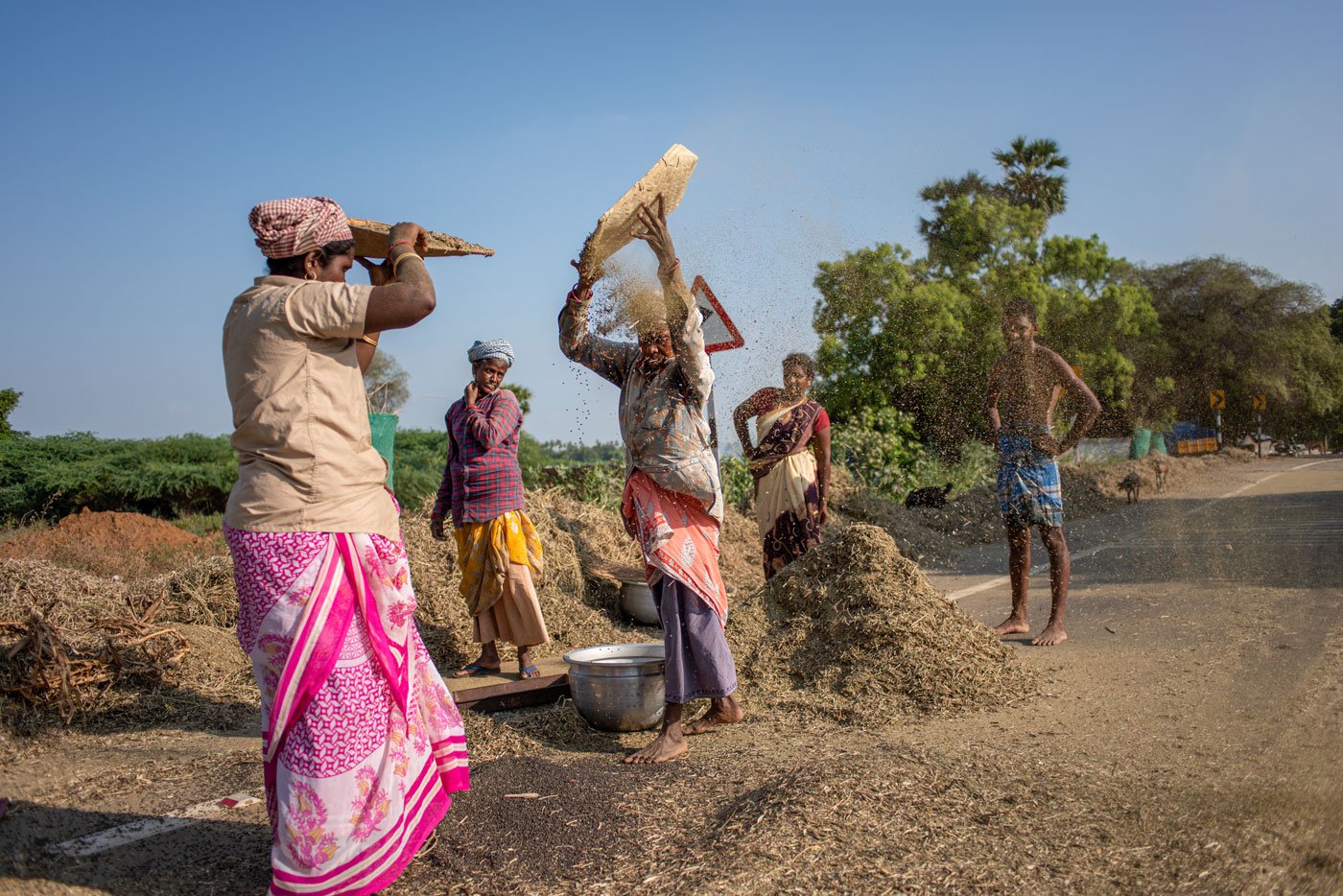
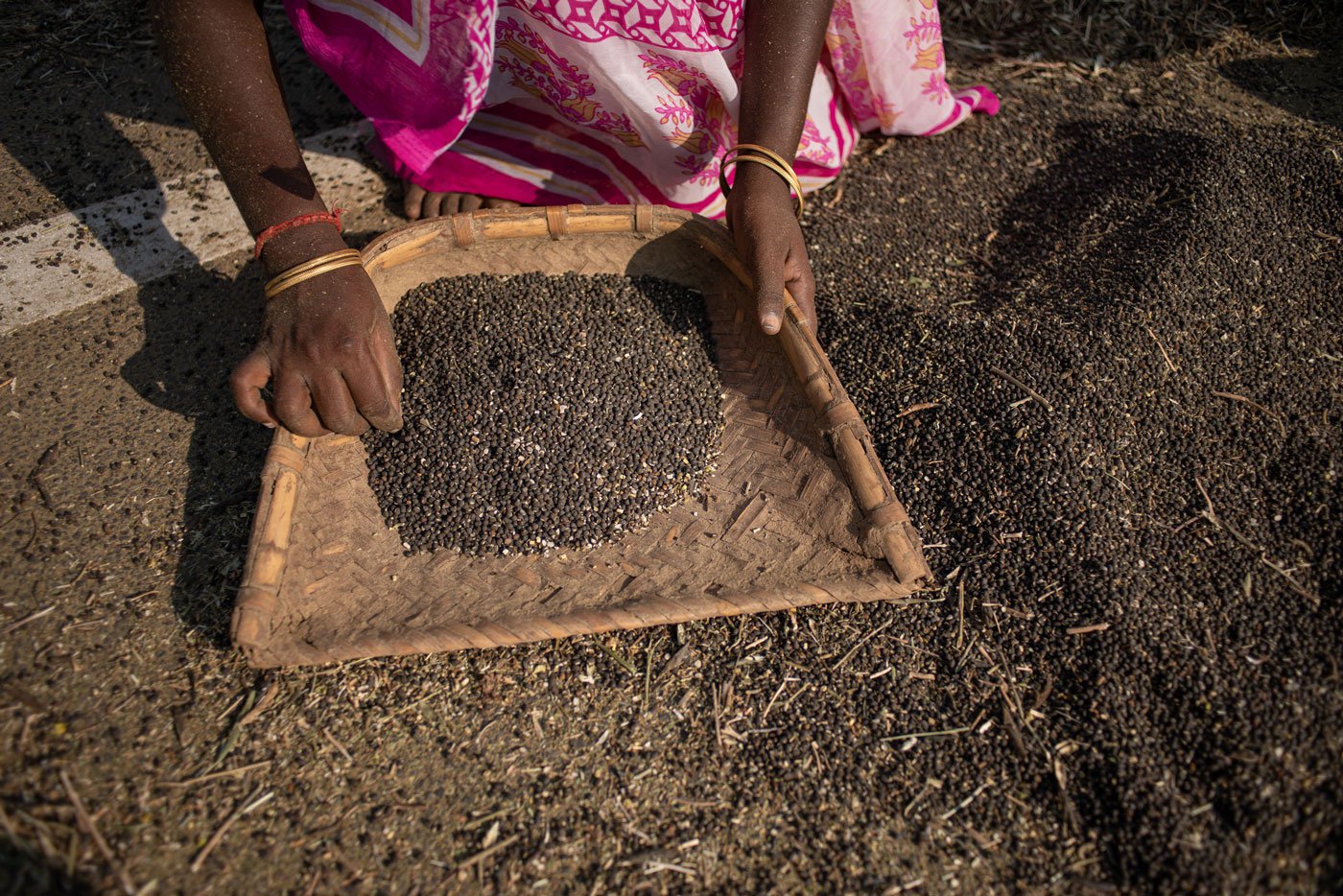
Women workers winnow (left) the freshly harvested black gram after which they clean and sort (right)
So, the couple hire labour. When they can get them. For the weeding and transplanting and threshing sesame, they mostly get older women to come in and do the work.
Black gram is equally hard. “It rained just before and after the harvest, I had such a terrible time, trying to keep it dry.” He describes his ordeal and the effort sounds super human. It makes me respect the ulundu (black gram) in my idli and dosai a lot more.
“I used to drive a lorry in my twenties. It had 14 wheels. We were two drivers and we took turns, and went all over the country. Uttar Pradesh, Delhi, Kashmir, Rajasthan, Gujarat…” He tells me what they ate and drank (camel milk tea, roti and dal , egg burji), where they bathed (by a river, or sometimes they didn’t, like when it was so cold in Srinagar), what they listened as they drove (“Ilaiyaraja songs, of course and Kuthu paatu , to keep us awake!”). He talks fondly of the camaraderie, the gossips, and ghosts. “One night, I got down from the truck to relieve myself. I had a blanket over my head. The next morning, the other chaps said they saw a hooded ghost!” And he laughs.
He quit cross-country driving as it took him away from
home for weeks. After his marriage, he drove locally, and farmed. Vadivelan and
Priya have two children – a daughter who’s in Class 10 and a son in Class
seven. “We try to give them everything, but maybe I was happier as a young
boy,” he says thoughtfully.
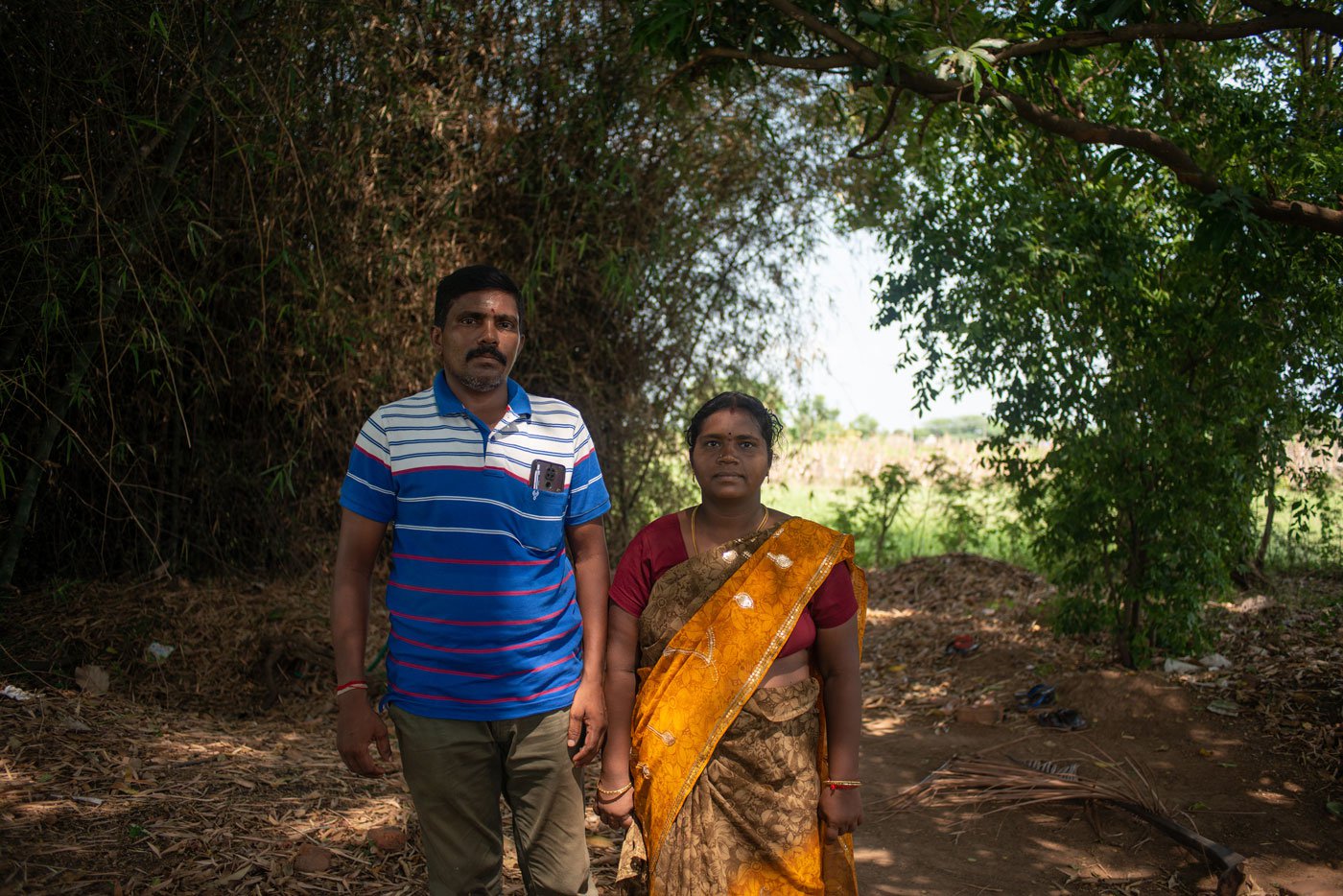
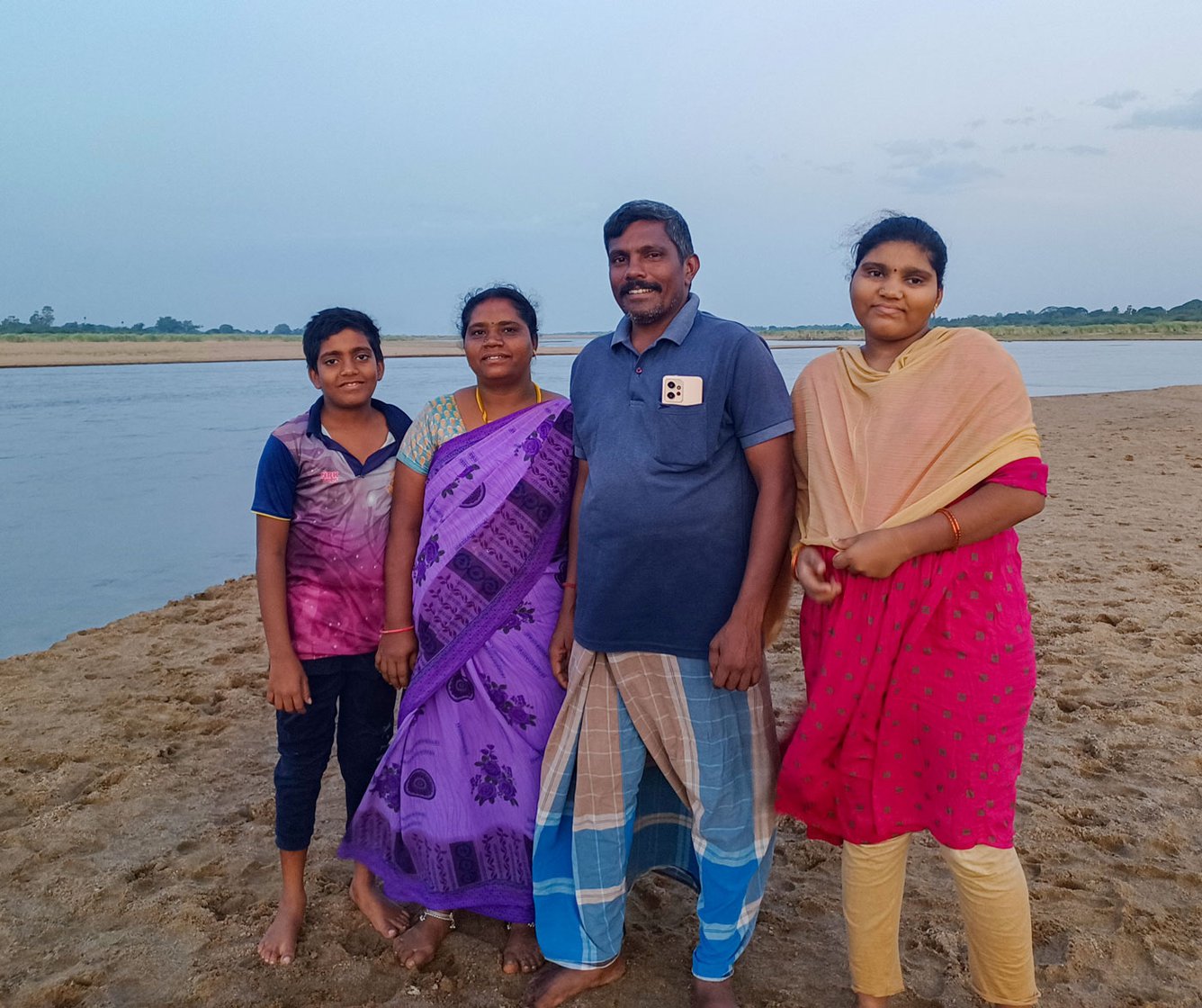
Vadivelan’s time is divided between farming and driving. Seen here (left)with his wife
Priya in the shade of a nearby grove and with their children (right)
The stories of his childhood are not easy. “Back then, nobody really raised us, you know,” he turns and smiles at me. “We just grew up.” He got his first pair of slippers when he was in Class nine. Until then, he went around barefoot, often taking the leafy greens that his grandmother foraged or grew and sold each bundle for 50 paise. “Some people would bargain even for that!” he sighs. He went around on a bicycle, with a vest and shorts given by the school. “It would last us three months. My family got us new clothes only once a year.”
Vadivelan vaulted over the tough times. He was athletic, and ran races, won prizes. He played kabbadi, swam in the river, hung out with friends, and at home, listened to the stories his appayi (paternal grandmother), told him every night. “I would sleep halfway, and the next night, she would start from there. She knew so many stories, of kings and queens and gods…”
But young Vadivelan was unable to compete at the district level, as his family couldn’t afford the gear and diet. At home the food was porridge, rice and gravies and sometimes meat. At school, he got upma for lunch. And in the evening, he remembers drinking rice-water and salt as a ‘snack’. He uses the word on purpose. And he buys his children packaged ones now.
He also shields them from the hardships of his childhood. The second time I visit his town, on the banks of the Kollidam, his wife and daughter dig the sand. Six inches in, water trickles up. “This river has pure water,” Priya says. She makes a mound, hides a hairpin, her daughter looks for it. Vadivelan and his son take a bath in the shallow water. We’re the only people around, as far as I can see. There are footprints in the sand, of cows going home. The river grass rustles. It’s beautiful in the way only vast, open spaces can be. “You can’t get this in your city,” Vadivelan says, leading the way back home. “Can you?”
*****
The next time I meet the river, it feels like I’m in the city. It’s a crush. It is August 2023, more than a year after my first visit to Vadivelan’s town. I’m here for Aadi Perukku , celebrated on the banks of Cauvery, where history, culture and ritual meet on the riverbank.
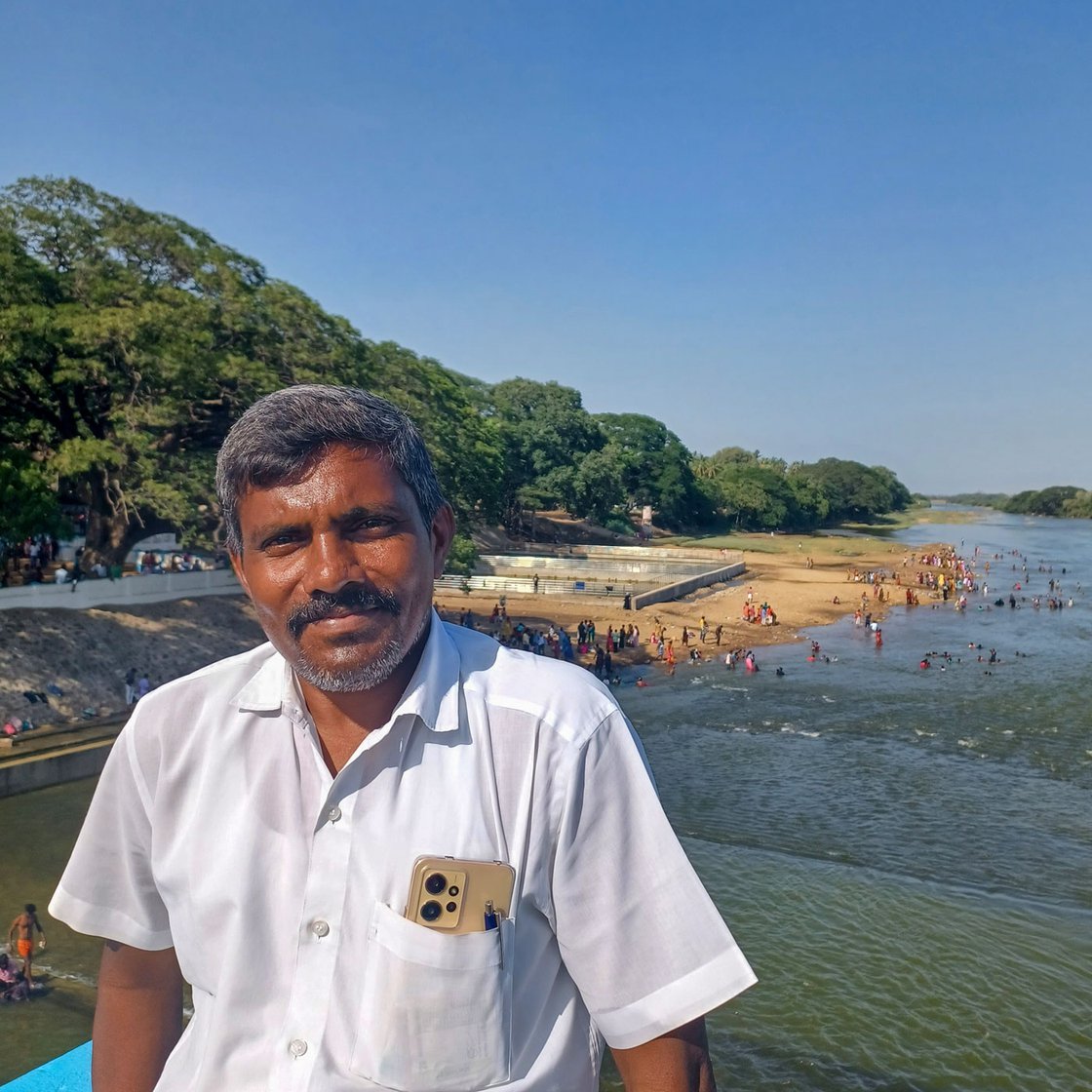
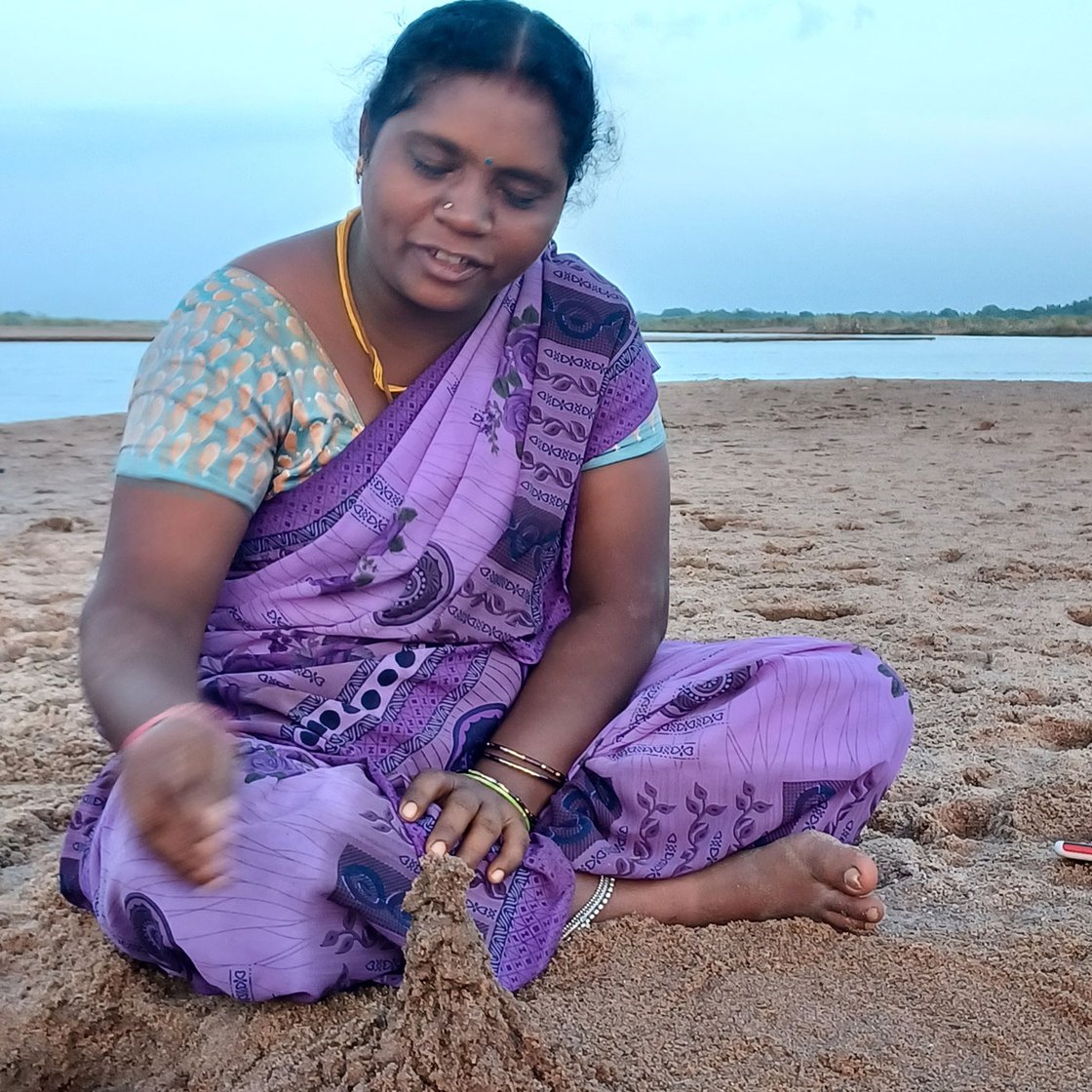
Vadivelan at a nearby dam on the Cauvery (left) and Priya at the Kollidam river bank (right)
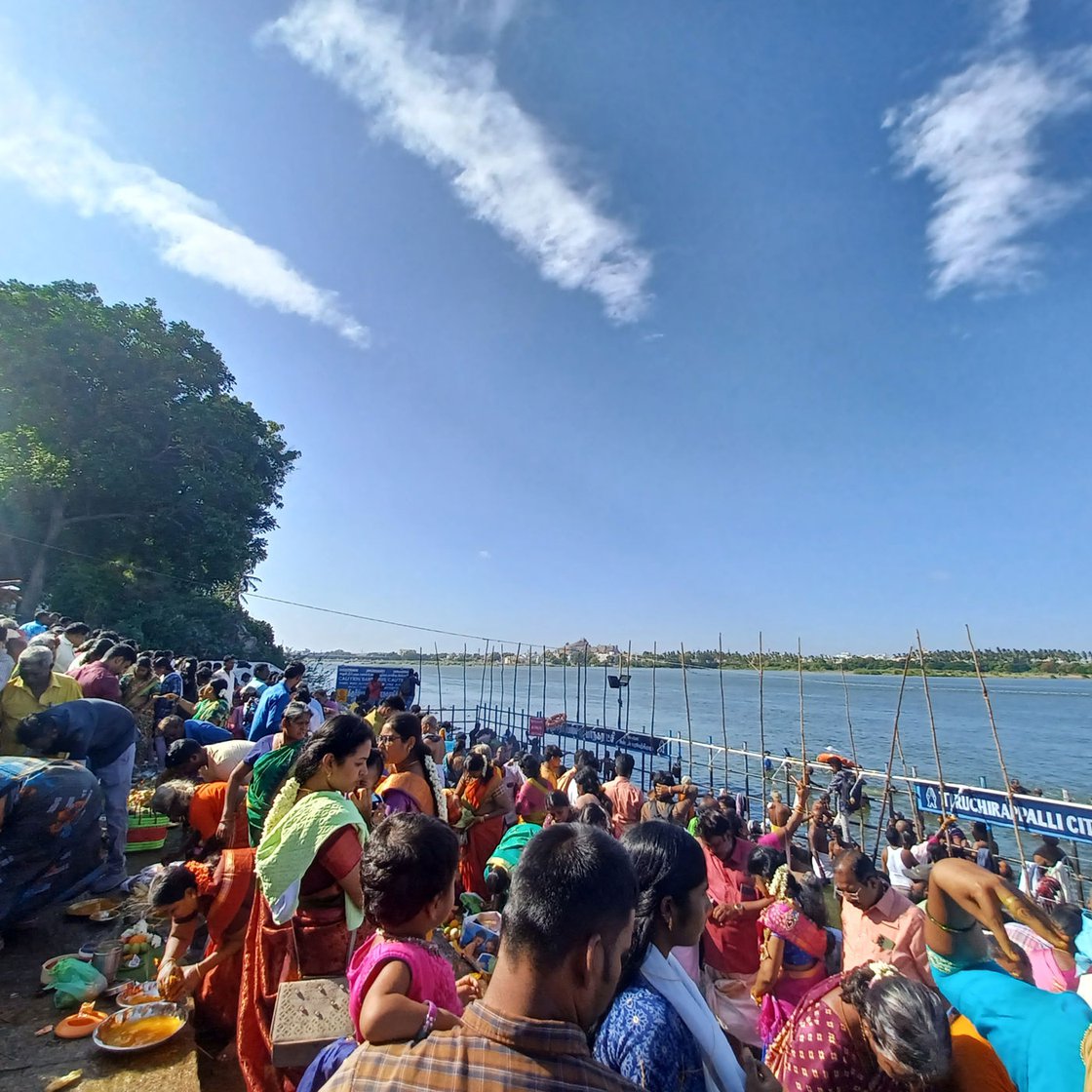
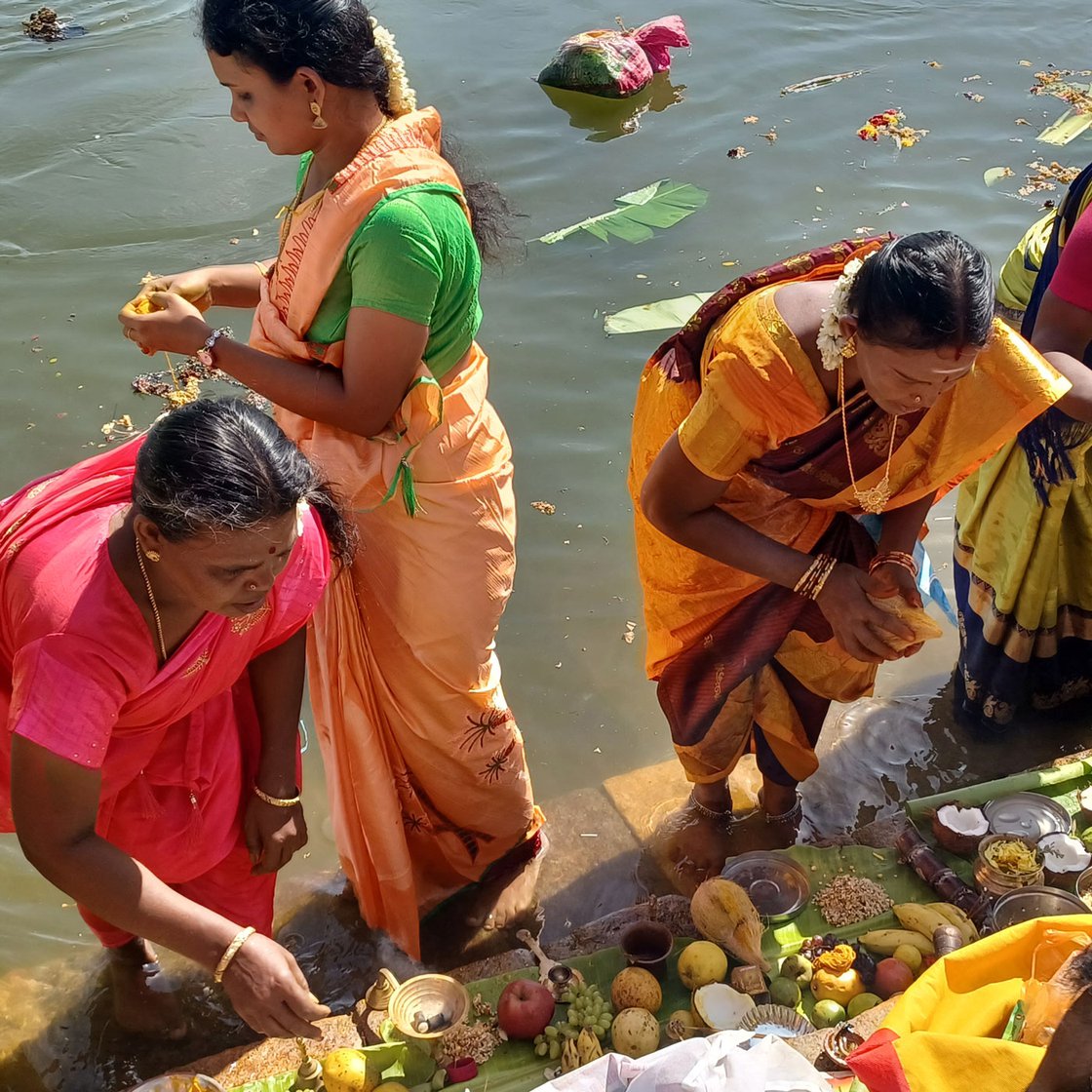
The crowd at Amma Mandapam (left), a ghat on the Cauvery on the occasion of Aadi Perukku where the river (right) is worshipped with flowers, fruits, coconut, incense and camphor
“It’s going to be crowded,” Vadivelan warns, parking the car in a quiet bylane in Srirangam. We walk to Amma Mandapam, a ghat on the Cauvery where pilgrims gather. It’s only 8:30 a.m. and it’s packed. There is no place on the steps, they’re filled with people and plantain leaves, with offerings for the river – coconuts, bananas pierced with incense sticks, small turmeric Ganeshas, flowers, fruits and camphor. The atmosphere is festive, like a wedding, only bigger.
Newly-weds and their families gather around priests, who help them restring the gold ornaments of the thali [mangalsutra] on to a new thread. Then the husband and wife pray, and throw their carefully preserved wedding garland into the water. Women tie turmeric threads on one another’s neck. They offer kumkum and sweets to family and friends. The Uchi Pillaiyar Koil, Trichy’s famous Lord Ganesha temple, shines in the morning sun across the Cauvery.
And the river flows swiftly, carrying prayers and wishes, irrigating fields and dreams, as she has, for thousands of years…
The author would like to thank Dr. Richa Kumar, for sharing the paper From Self-Reliance To Deepening Distress: The Ambivalence of the Yellow Revolution in India.
This research study is funded by Azim Premji University as part of its Research Funding Programme 2020.
